




Pact’s Sustainability Report (Report) represents our commitment to enhance transparency, accountability and performance. It outlines and reflects on the impact of the Group’s operations and supply chain, focusing on social and environmental impacts, alongside our governance and leadership principles.
Nine material topics are considered representing issues we know are important to our internal and external stakeholders. These nine topics have been organised into three pillars: Planet, People and Principles.
This year we have engaged an external assurer to review our energy and emissions reporting to continue setting a high level of accuracy on these key material topics in the organisation. The Assurance Report can be found on page 98.
This Report has been prepared in accordance with the Global Reporting Initiative (GRI) standards. Detailed mapping of this framework can be found on pages 95 - 96. The information contained in this Report relates to sites wholly owned and operated by Pact Group Holdings Ltd (Pact or the Company) and its wholly-owned subsidiaries (the Group or Pact Group). This Report also includes information about joint ventures operated by the Group. References to FY denote financial years, while all other dates refer to calendar years.
All monetary amounts in the Report are Australian dollars, unless otherwise stated.
Information Integrity And Verification
Pact’s Executive Leadership Team (ELT) is responsible for the preparation and integrity of the information in this Report. We believe this Report fairly represents our sustainability performance during FY25.
Further Information
Further information regarding Pact’s sustainability performance is communicated through various channels including Pact's website
If you have any questions or feedback, please email: info@pactgroup.com.


Discover how Pact is leading circular solutions through reuse and recycling; packaging; and consumer products.
Scan this QR code or visit pactgroup.com/sustainability
As we reflect on our sustainability journey in FY25, we continue to strengthen our position as a leader in the circular economy through our responsible business practices and environmental stewardship.
This year, we have made significant progress in embedding Environmental, Social, and Governance (ESG) principles throughout our organisation, guided by our steadfast commitment to a more sustainable and resilient future.
Recognising the importance of robust governance, we established the ESG Steering Committee, chaired by myself and supported by a dedicated cross-functional team of executives. This committee is driving our ambition to integrate ESG into the fabric of our operations while enhancing our capabilities in systems, data, processes and people.
In line with our long-term Vision, we launched our Impact 2030 Targets, which set clear benchmarks for our sustainability performance. Our commitments include:
• achieving net zero emissions by 2050;
• attaining a top quartile ESG score by 2030;
• ensuring 100% of our packaging is recyclable by 2030; and
• achieving 30% average recycled content across our portfolio by 2030.
We are proud that our Science Based Targets initiative (SBTi) Net Zero Targets have been approved, reaffirming our resolve to tackle climate change and reduce our environmental footprint.
Our efforts are already yielding measurable results, with a marked decrease in Scope 1 and 2 emissions in FY25, and we remain focused on accelerating this progress in the years ahead.
As a signatory to the United Nations Global Compact (UNGC), we accept our role as a responsible employer and remain committed to supporting the Sustainable Development Goals (SDG). Pact will continue to deliver against the SDG through our Circular Economy Strategy and this Report describes our actions.
In FY25, we increased the use of recycled resin to an average of 16% across our portfolio, which equates to a 4% increase compared to FY24.
Approximately 62,800 tonnes of recycled material was reprocessed and sold or used internally, which represents a 6% increase from FY24.
Pact’s strong sustainability performance is driven by the passion and commitment of our people. I’m incredibly proud of our talented and dedicated employees who consistently champion our Vision and Values for the benefit of our company and all stakeholders.
As we move forward, Pact remains committed to driving positive impact for our stakeholders, our communities and our planet. Together, we are building a more sustainable future, underpinned by innovation, collaboration and accountability.

Sanjay Dayal Managing Director & Group CEO
Vision: Lead the Circular Economy
Values:

~5,230 employees
Our Capabilities
Packaging
Reuse
Recycling
Contract Manufacturing
~120 locations
Headquartered in Melbourne, Australia
Net Revenue
$1,821.7 Billion
15 countries
In FY25, Pact refined its Mission and Purpose to ensure alignment with its long-term Vision to lead the circular economy.
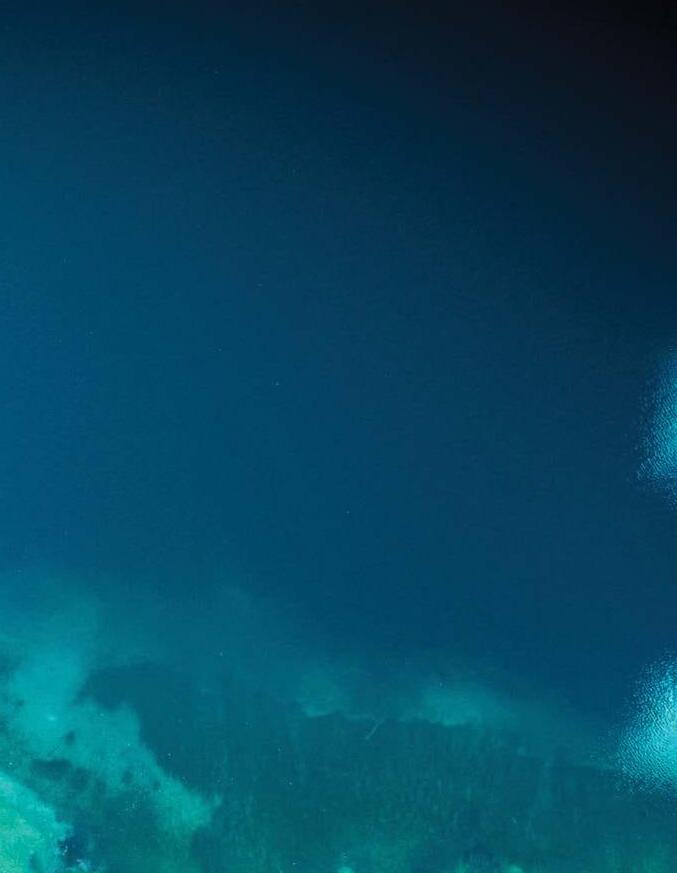
Deliver scaled circular solutions through reuse and recycling; packaging; and consumer products
To advance our refreshed Mission and Purpose, Pact introduced a new set of ambitious environmental, social and governance targets in FY25.
Our Impact 2030 Targets, set out in detail on pages 13 - 14, represent a bold, measurable commitment to sustainability, circularity and ethical business practices. They supersede the 2025 End of Waste Targets established in 2018 and are designed to align Pact’s operations with evolving customer expectations, regulatory requirements and global sustainability benchmarks.
SBTi Net Zero Targets approved.
62,800
tonnes
of recycled material reprocessed and sold (or used internally) which represents a 6% increase from FY24.
11.2%
decrease
in Scope 1 & 2 emissions (from a FY21 baseline).
~16%
inclusion of recycled resin across our portfolio. This equates to a 4% increase from FY24.
Pact’s rFresh-100
Pact’s food-grade recycled High Density Polyethylene (rHDPE) passed rigorous testing to meet US Food and Drug Administration safety requirements.
2
Packaging Innovation and Design Awards (PIDA) for sustainable packaging.
Launch of Pact’s inaugural Succeeding at Pact Guide.
Achieved an employee engagement score of 76%
This is 3% above the Asia Pacific region (APAC)* manufacturing sector average.
* Source: Culture Amp, Manufacturing APAC, January 2025 Benchmark.
5,663
peer-to-peer performance recognitions.
Decreased pay disparity for salaried roles in Australia and New Zealand (excluding CEO and ELT positions) from 4.2% to 4.0%.
Achieved
31%
female representation in our Senior Leadership Team.
ESG Steering Committee established to embed environmental, social and governance priorities into core operations, and accelerate progress toward our sustainability ambitions.
Launched our Impact 2030 Targets which are bold and measurable commitments to sustainability, circularity and ethical business practices:
+ Net zero by 2050 + Top quartile ESG score by 2030
of our Community Giving Budget allocated to support charities that align with our Vision, reflect our Values and benefit the communities we operate in.
+ 100% recyclable packaging by 2030 + 30% average recycled content across our portfolio by 2030. corporate policies new internal policies adopted. refreshed to strengthen governance. 14
3
A circular economy is a systematic approach to economic development designed to benefit businesses, society and the environment. It is regenerative and aims to gradually decouple growth from the consumption of finite resources.
The circular economy transforms the linear consumption approach (take-make-waste) into a circular one that keeps resources in circulation for longer. This approach reduces environmental impacts and protects natural resources. Since incorporation, Pact has been a driver of the circular economy through Packaging, Contract Manufacturing, Reuse and Recycling solutions.
Cross industry collaboration, JV partnerships and government support
Access to high-quality, locally-processed recycled material
World-class sorting, washing and processing technologies
Innovation, design and material science
Advanced manufacturing platforms
Research and Development and New Product Development experts Pact’s role in the circular economy
Use & Reuse
Sorting, redistribution facilities
World-class asset pooling and reconditioning services
Quality and Compliance






new product launches $10M Sales delivered through Innovation 7 out of 7 contract manufacturing sites SEDEX members Hangers, accessories, size clips and security tags



Smarter, scalable and sustainable contract manufacturing solutions in FY25:

Pioneering a whole of product lifecycle approach to sustainable packaging.
In our Packaging division, resin is the primary material used. In FY25, Pact consumed more than 200,000 tonnes of resin to produce packaging. By the end of FY25, the average amount of recycled content within our plastic portfolio was approximately 16%.
In FY25, our Packaging divisions consumed more than 22,200 tonnes of steel and 4,300 tonnes of tinplate to produce more than 7 million metal pails, drums and cans.
In FY25, Pact Contract Manufacturing sourced more than 800 tonnes of tinplate packaging for our own brand aerosol products.

Eliminating single use through reuse solutions.
In FY25 Pact Retail Solutions redistributed more than 1.023 billion hangers, accessories and size clips and 124 million security tags for reuse. Keeping these materials in circulation has diverted more than 17,800 tonnes1 of waste from landfill.
In FY25 Pact collected more than 348,000 used steel drums, 19,800 plastic drums and 195,300 IBCs for reconditioning. Steel drums and IBCs that cannot be reconditioned are recycled.


Pact’s Contract Manufacturing division continues to lead with innovation and operational excellence, delivering high-quality solutions across liquids, powders, aerosols and therapeutic wellness products. With a diversified portfolio and strong customer partnerships, the division is not just manufacturing, it is co-creating the future of sustainable consumer goods.
In FY25, bold steps were taken to embed sustainability deeper into operations.
Energy and Carbon Leadership at Keysborough
In FY25, a comprehensive energy and carbon assessment was initiated to identify opportunities for enhancing overall energy efficiency at the Keysborough facility. The objective of this assessment is to develop a scalable framework that can be applied across other facilities with similar operational characteristics.
Sustainable Packaging in Action
In collaboration with a major customer, desiccants (which are not recyclable) were successfully eliminated from their product range — a small change with a significant environmental impact. This initiative demonstrates a strong commitment to circularity and customer-led innovation.
Pact Group is one of the largest plastics recyclers in Australasia.
In FY25 Pact Recycling sites reprocessed and sold 62,800 tonnes of resin which was utilised internally or sold. This is an increase of approximately 3,800 tonnes or 6% compared to FY24.
Meaningful stakeholder engagement is recognised as a critical driver of ongoing ESG advancement.
Our stakeholders include our team members, customers, investors, suppliers, end consumers, local communities, industry bodies, governments, regulatory authorities, non-government organisations and academia. Each plays a vital role in shaping our business and sustainability outcomes.
We are committed to fostering open, transparent and ongoing dialogue with our stakeholders. Through a range of engagement mechanisms, we share information, exchange feedback, address concerns and collaborate on initiatives that drive positive impact.
from
Achieving 91% participation and 76% engagement in our Pact Pulse Employee Survey reflecting strong employee connection and commitment to the Group and its Vision and Values.
Contributing to Key Industry Groups:
• Society of Plastics Engineers, Australia and New Zealand
• Plastics New Zealand
• WasteMINZ, New Zealand
• Australian Council of Recycling (ACOR)
• Chemistry Australia
• Recycling Victoria.
Participating in two Australian Packaging Covenant Organisation (APCO) Working Groups and Advisory Committees:
• Technical Advisory Committee
• Collective Action Group.
Presenting at the 2025 AIP Australasian Packaging Conference
Receiving two Australasian Packaging Innovation and Design Awards in the sustainability category.
Earning customer awards from Swisse and Fisher & Paykel for sustainability leadership.
Hosting the Agrig8 Industry Event for >100 members of the AgSafe Product Stewardship program
Launching five new brands of recycled resins to our customer base.
Consulting with the Department of Climate Change, Energy, the Environment and Water on packaging regulation reforms.

The material topics addressed in this Report are in line with the priorities identified for Pact Group and its stakeholders, in accordance with GRI Universal Standards 2021. Our material topics directly inform our ESG Strategy.
By identifying and taking action in response to material sustainability issues, we can create value for our stakeholders and the wider community. Our material topics are listed on page 13 - 14.
Annually we undertake materiality assessments to determine the most important sustainability issues for our stakeholders. We use these findings to inform our ESG Strategy and prioritise our initiatives to ensure we have meaningful metrics against which to measure our performance. The analysis provides a basis for the structure and content of this Report
Separate reporting on Pact’s operational business risks can be found in our Annual Repor t
Our materiality process considers Pact’s economic, environmental and social impacts and the consequences and risks associated with these, in consultation with our stakeholders.
Our materiality analysis considers our business activities and relationships with our stakeholders, and the sustainability context in which these occur. This review provides Pact with critical information to identify our actual and potential impacts.
We review the previous year’s list of material topics and reflect on: material topics and sustainability challenges of like companies; media coverage of the manufacturing industry; relevant ESG frameworks and standards (including GRI, Carbon Disclosure Project, EcoVadis and APCO); our Vision and Values; and the areas of interest identified by stakeholders and the global community in general. Through this process, we develop an updated list of sustainability issues relevant to Pact and our stakeholders.
We regularly consult our stakeholders (detailed on page 11) to understand the topics that are important to them and our business. The feedback we gather throughout the year informs our materiality assessment. From this feedback, we use a weighting process to prioritise the topics identified in the previous step. This engagement solidifies our materials topics list. In FY25, we identified nine material topics and these form the structure of this analysis.
Our list of material topics is reviewed by our risk team, senior management and the Board.
Through engagement with our key stakeholders, we have identified nine material topics for Pact Group in FY25.
In this Report, we have grouped analysis on these topics into three pillars. Each pillar comes with its own unique set of goals and commitments.













+ 30% average recycled content across our portfolio by 2030
+ 100% of our portfolio to be recyclable by 2030
+ Scope 1 & 2 emissions: 50% reduction by end 2030 from a
+ Net zero carbon emissions by 2050
+ Scope 3 emissions: 25% reduction by end 2030 from a FY24
+ Net zero carbon emissions by 2050
+ Zero recyclable waste to landfill by 2030
+ 15% water efficiency improvement at Pact Recycling sites
+ 100% of sites to have completed a critical health and safety self-assessment annually
+ 100% of high risk exposures identified assigned actions
+ 100% Serious Injury or Fatality (SIF)/Potential Serious Injury (PSIF) investigated and closed annually
+ Pay equity by gender at each level of the organisation by
+ 30% direct reports to the ELT (excluding administration) by 2030
+ Employee engagement score above manufacturing industry benchmark (assessed biennially)




+ 1st quartile ESG performance as 3rd party assessed by 2030
+ 80% of Pact’s key suppliers to have completed an ESG assessment by 2026
+ Reduce Scope 3 emissions by 10%, from a FY24 base year, through sustainable procurement and supplier engagement
+ 100% of our Community Giving Budget allocated to support high-impact charities that align with our Vision, reflect our and benefit the communities we operate in
This Report provides transparent insight into our performance against each target. To clearly communicate our journey, we have grouped our progress into three categories:
We established our Impact 2030 Targets in FY25 to provide us with a bold and purposedriven roadmap to accelerate meaningful progress across our ESG pillars. These targets reflect our commitment to creating lasting change and driving impact where it matters most—for our people, our communities and our planet.
a FY21 base year
FY24 base year
Decreased our consumption of non-recyclable, problematic plastics by 235 tonnes.
*base year adjustment required; refer to page 40.
Progress toward this target will be reported in the FY26 Sustainability Report
sites by 2030 Progress toward this target will be reported in the FY26 Sustainability Report
This is 3% above the Asia Pacific region (APAC)* manufacturing sector average.
* Source: Culture Amp, Manufacturing APAC, January 2025 Benchmark.
assessment Progress toward this target will be reported in the FY26 Sustainability Report year, by 2030 engagement Progress toward this target will be reported in the FY26 Sustainability Report support our Values
Commencing – Targets where foundational work has begun. Progressing – Targets with measurable momentum and ongoing implementation. Achieving – Targets where we are consistently meeting or exceeding expectations.

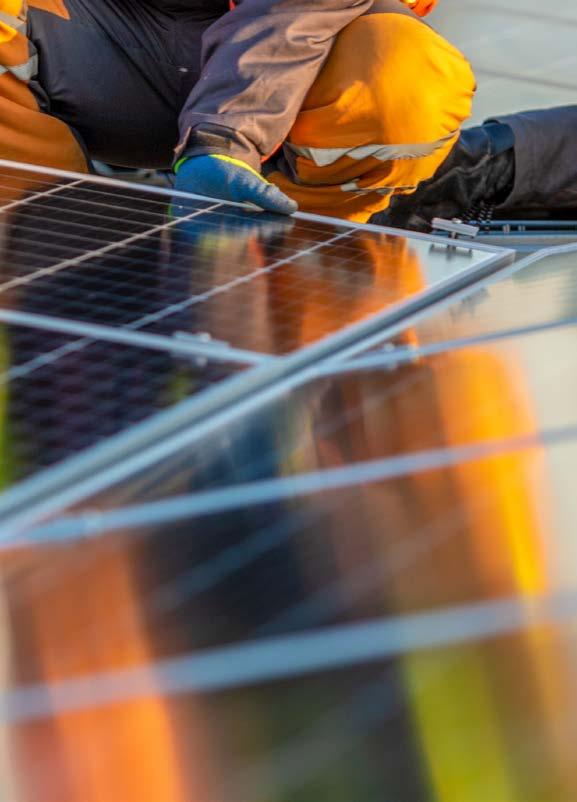
Reducing our environmental impact for future generations and accelerating our progress towards our Impact 2030 Targets.
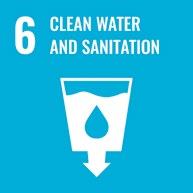


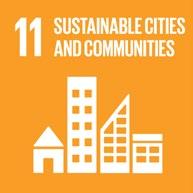
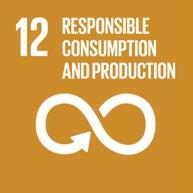
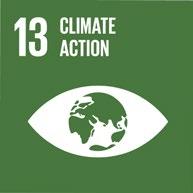

+ 30% average recycled content across our portfolio by 2030
+ 100% of our portfolio to be recyclable by 2030
Circularity
Climate
+ Scope 1 & 2 emissions: 50% reduction by end 2030 from a FY21 base year
+ Net zero carbon emissions by 2050
+ Scope 3 emissions: 25% reduction by end 2030 from a FY24 base year
+ Net zero carbon emissions by 2050
Waste & Water
+ Zero recyclable waste to landfill by 2030
+ 15% water efficiency improvement at Pact Recycling sites by 2030
By keeping materials in use for longer through reuse, recycling and remanufacturing, we reduce reliance on virgin resources and significantly cut waste. This regenerative model transforms the traditional ‘take-make-waste’ approach into a closed-loop system that benefits the environment, society and the economy.
30% average recycled content across our portfolio by 2030
FY25 Progress (compared to FY24)
By the end of FY25, the average amount of recycled content across our plastics portfolio was approximately an increase of 4%
Increased the amount of recycled plastic we produced by or more than Recycled material produced which was utilised internally or sold (tonnes)
6% 16% tonnes
3,800

Transitioned Hive and Wellness’ Barnes Natural 500ml Apple Cider Vinegar bottles to 30% locally sourced and processed rPET. This keeps of rPET in the circular economy per annum.
5.2 tonnes 70%
Transitioned Unilever’s 400ml bodywash bottle range to post-consumer recycled resin. These bottles are now made with material that was sourced from Australian kerbside bins, sorted at Cleanaway, recycled at Circular Plastics Australia and re-manufactured by Pact.

30%
Partnered with Colgate’s Cuddly brand to make their 850ml laundry rinse bottles with locally sourced, post-consumer recycled resin.

In FY25, Pact’s recycling facilities processed over 62,800 tonnes of recycled material—an increase of approximately 6% from the previous year. These facilities handle a wide range of plastic polymers sourced from kerbside collections, pre-consumer waste and product stewardship programs. The recycled resins are used to replace virgin materials in the manufacturing of new products, supporting Pact’s commitment to a circular economy.
Circular Plastics Australia (PET)
Circular Plastics Australia (PE)

Circular Plastics Australia (PET) is a joint venture between Pact Group, Cleanaway, Asahi Beverages and Coca-Cola Europacific Partners.
One PET recycling plant is in Albury (NSW) and the second facility is located in Laverton (VIC).
Each facility has the capacity to recycle more than 20,000 tonnes per annum.
Circular Plastics Australia (PE) is a joint venture between Pact Group and Cleanaway.
Located in Laverton (VIC), this facility has the capacity to process more than 20,000 tonnes of HDPE and PP bottles, containers and food tubs every year.
In FY25, the two Pact-operated Circular Plastics Australia (CPA (PET)) recycling plants processed 77% of the plastic beverage bottles collected by Australia’s container deposit schemes.
Overall, the two facilities in Melbourne (VIC) and Albury (NSW), collectively processed more than 39,215 tonnes of PET plastic beverage bottles last year the equivalent of 1.98 billion 600ml soft drink bottles.
These bottles are recycled into high-quality, food-grade PET resin which is used to manufacture new PET beverage bottles by CPA (PET) partners Asahi Beverages and Coca-Cola Europacific Partners for their range of soft drinks and water.
Once these bottles are returned by consumers for a 10c refund via container deposit schemes they are recycled again.
Pact Group also uses the recycled PET to make food packaging such as meat trays, fruit punnets, bakery packaging, and mayonnaise and honey jars.
In FY25, plastic resin made from recycled milk and juice bottles at a Pact-operated recycling facility in Melbourne passed rigorous testing to meet US Food and Drug Administration (FDA) safety requirements for use in HDPE food and drink packaging.
The rFresh-100 rHDPE resin is produced at the Circular Plastics Australia (PE) (CPA (PE)) recycling facility in Laverton. This recycled resin is derived from plastic milk and juice bottles collected through kerbside recycling programs. The bottles undergo a rigorous process of sorting, shredding, washing and sanitisation before being converted into a high-quality, food-grade resin suitable for packaging applications.
Milk bottles made with recycled rFresh-100 resin were tested in international facilities and met food safety requirements under FDA 21 CFR 177.1520. These food-contact tests included both chemical end tests and sensory assessments. FDA compliance means that new milk and juice bottles can be manufactured from up to 100% recycled rFresh-100 resin.
The CPA (PE) recycling facility in Laverton is also FSSC 22000-certified and the operations are supported by an on-site testing laboratory to assure the recycled resin complies with the FDA regulations.
The recycled rFresh-100 HDPE resin will be used to make milk, cream, sauce and juice bottles, and personal care containers at Pact’s packaging manufacturing facilities throughout Australia.
The CPA (PE) facility, a joint venture between Pact and Cleanaway Waste Management, has the capacity to recycle up to 20,000 tonnes of HDPE milk, dairy and juice bottles a year, or the equivalent of half a billion 2L milk bottles.

Pact Group’s recycled Sulo bins won the top honour at the 2025 Australasian Packaging Innovation & Design Awards in the recycled content category.
Sulo was recognised for the 120L and 240L kerbside mobile garbage bins which are now made from up to 100% of recycled resin produced from used packaging such as shampoo, detergent and sauce bottles, as well as lids from jars and bottles, collected from kerbside recycling bins.
Making Sulo garbage bins using recycled plastic reduces the need to use virgin resin sourced from fossil fuels and diverts thousands of tonnes of plastic waste from landfill each year.
The packaging waste is recycled at the Pact-operated CPA (PE) recycling facility in Laverton (VIC), where it is sorted, shredded and washed in the state-of-the-art facility and turned into a high-quality recycled resin.
Sulo bins are manufactured in dark colours such as black and dark green, which enables them to be made with the highest quantity of locally sourced, post-consumer recycled plastic.
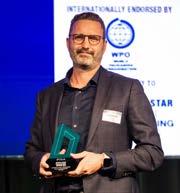
SULO’S CIRCULAR STORY
RECYCLABLE BIN CONTENT
Removing problematic plastics is a critical step toward building a circular economy. Materials such as polystyrene (PS), polyvinyl chloride (PVC) and multi-layer laminates are difficult to recycle, contaminate waste streams and often contain harmful chemicals. By eliminating them, we reduce landfill waste, protect ecosystems and improve the quality of recycled materials.
100% of our portfolio to be recyclable by 2030
FY25 Progress (compared to FY24)
Decreased production of PS packaging by or more than
Decreased production of PVC packaging by or more than
50 31% 11% tonnes tonnes
185
Light-weighting, also called thin walling or down gauging, is the process of redesigning packaging to reduce its overall weight without compromising its structural integrity, performance, or recyclability. This approach not only decreases the volume of raw materials required but also reduces energy consumption during manufacturing and transportation, leading to lower emissions.
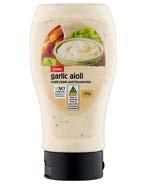
In FY25, Pact transitioned
35
In FY25, Pact partnered with Colgate to transition their black 5 litre and 2 litre bottles to carbon black free masterbatch, delivering an extra
55 tonnes tonnes
of flip-top PP caps on Coles and Woolworths squeeze bottle packs to fully recyclable carbon black free masterbatch. of recyclable packaging.

In FY25, Pact partnered with Hilton Foods to light-weight a range of mono PET meat trays. Across four trays sizes, Pact reduced the total weight of raw material by 207tonnes.
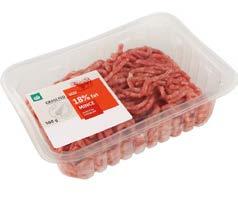

Pact won a 2025 PIDA for PFAS reduction, recognising the transition of ADAMA’s 5 litre to 20 litre agrichemical range into Pact’s plasma-coated containers.
The licensed plasma coating technology applies a safe and leakage-free internal solvent resistant barrier that removes the need for fluorination (which causes PFAS).
Pact's plasma coated containers are recyclable through the relevant recycling programs such as drumMUSTER® in Australia and AgRecovery in New Zealand.
Pact’s underground cable covers, made from 100% recycled plastic were used to protect live underground cables as part of the construction of the Glenellen Solar Farm.
Made from approximately 170 tonnes of hard-to-recycle plastic such as agricultural containers, laundry bottles, plastic bags, and stretch wrap and film, the cable covers will protect 96 kilometres of live wires.
Cable covers act as a shield against any future accidental penetration from digging equipment, providing a safe working environment for the next generation.
cable covers will protect
95 km of live wires

Pact is focused on creating packaging solutions that help our customers reduce their environmental impact. By working together and using smart design, Pact is helping lead the shift toward a circular economy — where materials are reused, recycled and kept in circulation for as long as possible.
We work closely with our customers to diagnose and mitigate environmental impacts associated with packaging. Our approach includes:
• Use of Life Cycle Assessments and the Packaging Impact Quick Evaluation Tool (PIQET) to identify emissions hotspots and opportunities for reduction.
• Application of the Packaging Recyclability Evaluation Portal (PREP) tool to assess recyclability and guide packaging design aligned with the Sustainable Packaging Guidelines (SPG) provided by the APCO.
• Assessing designs against recyclability principles to highlight if packaging is compatible with existing recycling systems.
These tools allow us to provide tailored recommendations that reduce carbon footprints and improve packaging sustainability across the entire lifecycle.
We continuously improve our manufacturing processes to reduce material consumption without compromising performance. This includes:
• Light-weighting packaging to use less material.
• Increasing the recycled content in our products – averaging 16% across our plastics portfolio in FY25.
• Transitioning to mono-material packaging to enhance recyclability and meet SPG criteria.
These optimisations not only reduce resource use but also deliver cost and emissions savings for our customers.
We support our customers in promoting proper disposal and circularity by:
• Guiding the application of the Australasian Recycling Label to our own-brand product to guide and improve consumer disposal behaviour.
• Designing packaging that aligns with the SPG, ensuring compatibility with kerbside recycling systems.
• Helping customers transition out of non-recyclable packaging, including problematic polymers such as PVC, PS and expanded polystyrene.
In FY25 alone, Pact diverted over 236 tonnes of problematic plastics from landfill through targeted packaging redesigns.
We continue to explore and trial bio-based resins across our product portfolio. Bio-based materials have been identified as one of Pact’s key levers for reducing emissions and advancing towards our Net Zero Target. These alternatives offer a pathway to reduce reliance on fossil fuels while supporting our sustainability goals and those of our customers.
Pact operated CPA (PET) hosted environment minister Tanya Plibersek, industry minister Ed Husic and Member for Gellibrand Tim Watts for the launch of the government’s ReMade in Australia brand campaign.
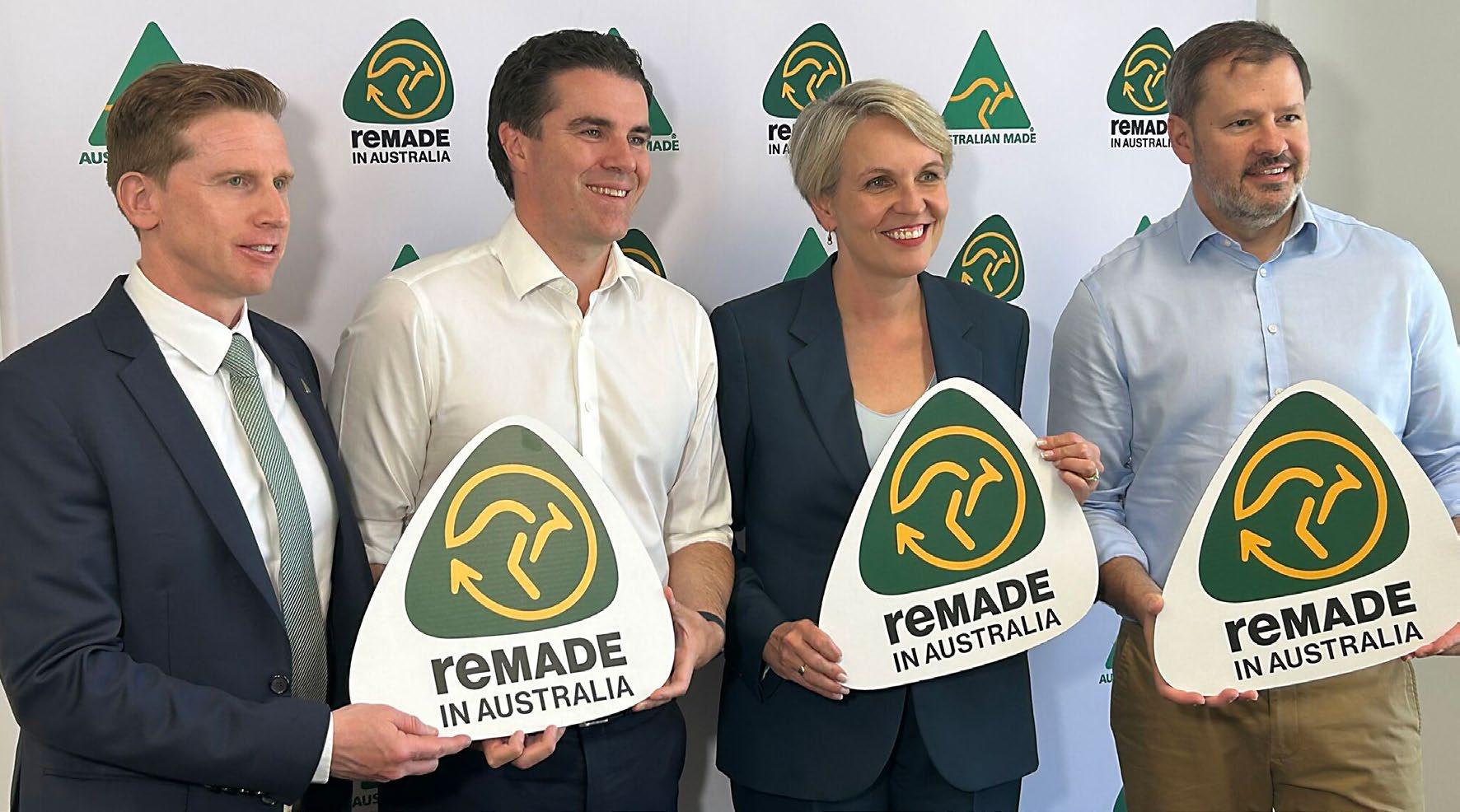
Pact participates in product stewardship schemes to support the transition to a circular economy and reduce the environmental impact of products across their lifecycle. By collaborating with industry and government through such programs, Pact helps recover and recycle materials like soft plastics, paint containers and garden pots that would otherwise go to landfill. These initiatives enable Pact to meet regulatory obligations under the Recycling and Waste Reduction Act 2020, while also creating new value from waste and reinforcing our commitment to sustainable innovation and responsible production.
drumMUSTER is an Australian product stewardship scheme that is supported by chemical manufacturers and the agricultural industry to collect and recycle eligible plastic and steel containers.
The plastic containers the Group collects are washed and granulated into recycled plastic flake. This recycled material is then used to manufacture industrial plastic products such as kerbside rubbish bins, underground cable covers and slipsheets.
In FY25, Pact collected and recycled 983,000 containers, equal to 740 tonnes of material.
Turning safety waste into sustainable innovation
Hard hats are essential safety gear, but did you know they need to be replaced regularly? That adds up to a lot of plastic waste.
That’s where Pact Recycling steps in. In partnership with Cleanline Tasman, RSEA and Safeworx, Pact Recycling collects and recycle stripped-back hard hats. The hats are dismantled, shredded into high-quality ABS granules, and then used in a range of industrial sheet applications including airport conveyor systems and thermoformed parts.
In FY25, 1 tonne of hard hats were recycled.
New nationwide recycling scheme gives caps and lids a second life
The Caps & Lids Recycling Scheme, launched in September 2024, allows consumers in New Zealand to drop off plastic (and metal) caps and lids at designated collection boxes in selected New World, PAK’nSAVE, and Four Square supermarkets across Auckland, Tauranga and Christchurch.
Pact Group is proud to be the plastic recycling partner of the scheme, ensuring collected plastic caps are reprocessed into recycled resins ready for re-manufacture into a range of new products.
In FY25, 5.7 tonnes of caps and lids were recycled.
PPG Drum stewardship program
Pact Recycling New Zealand and PPG have established a circular stewardship program for 200-litre steel open top drums that previously contained PPG paint.
Pact Recycling New Zealand facilitates the collection of drums from PPG and its primary clients where they undergo a cleaning and reconditioning process before being returned to PPG for refilling with new paint. One thousand drums have been reconditioned since the program commenced in late 2024.
This process can be repeated up to five or six times prior to the drum's retirement, at which point the scrap steel is recycled.
Plasback Silage Recycling Program (NZ)
Pact Recycling New Zealand partners with Plasback to recover used plastic bale wrap and silage material from farms and recycle it into new products.
The waste plastic is collected by farms in Plasback bins, bailed and sent to Pact Recycling NZ for recycling.
The recycled resin is manufactured into 100% recycled resin sheet which is used by Plasback to manufacture new collection bins.
In FY25, 8.55 tonnes of used bale and silage material was recycled.
Mitre 10 Pot Recycle Program
Pact Recycling New Zealand partners with Mitre 10 New Zealand on its Pot Recycle program. The nationwide Pot Recycle scheme provides a closed loop solution for polypropylene (PP) garden pots.
Customers wash and return their clean pots to Mitre 10 stores, where they are collected, shredded and melted into resin by recycling partners including Pact. The recycled resin is then remoulded into new pots and replanted by Zealandia Horticulture.
In FY25, 20.6 tonnes of used plant pots were recycled.
Seat Smart
Pact is a recycling partner for 3R Group’s SeatSmart product stewardship scheme which provides a recycling option for expired or damaged child car seats.
In FY25, Pact Recycling New Zealand recycled 1.5 tonnes of discarded seats, with the recycled material used to remanufacture a wide variety of products, including plant pots, shampoo bottles, building materials and electrical conduit.
In FY25, 1.5 tonnes of plastic from used car seats was recycled.
Used paint packaging stewardship programs
Pact Recycling New Zealand is a recycling partner to the Resene PaintWise program and the Dulux Paint Take Back Service.
Under these schemes, consumers return unwanted paint packaging to stores across New Zealand, where they are emptied, sorted and rinsed, and sent to Pact Recycling where they are rewashed, granulated and processed into recycled resin pellets to manufacture new paint pails.
In FY25, 1.25 tonnes of HDPE and 31 tonnes of PP paint pails were recycled.
The AgRecovery recycling network includes more than 160 fixed sites across New Zealand and on-farm collections for large items or large quantities of containers.
The collected HDPE plastic containers are recycled in New Zealand by Pact Recycling and made into reusable products such as underground cable cover and building materials.
In FY25, 237 tonnes of used HDPE agricultural containers were recycled.
Allproof and Pact Group ‘Close the Loop’ with 100% recycled channel drain
Pact Recycling New Zealand supplies post-consumer recycled polypropylene (rPP) to Allproof Industries, a family-owned New Zealand company specialising in the manufacture of drainage and passive fire protection products at its bronze Enviromark® certified facility in Auckland.
Allproof has released a range of commercial channel drains made with 100% rPP which have been installed at Pact’s Recycling site in East Tamaki.
Pact’s branded portfolio is built on a foundation of trust and responsibility, delivering high-quality products that meet the everyday needs of Australian households. Each product reflects Pact’s values of safety, innovation and integrity. As the business continues to grow, sustainability remains embedded at every stage of the product lifecycle, from design and sourcing to manufacturing and distribution.
We take product safety seriously. Our approach is proactive, transparent and customer-focused:
Health and safety transparency
Every product we manufacture undergoes a rigorous health and safety risk assessment as part of our Safety Data Sheet development process. These assessments ensure that we provide clear, accessible information to consumers about potential hazards and safe usage. Where applicable, we include the Poisons Information Centre hotline on our product labels to support immediate access to expert advice.
Product recall readiness
We maintain a formalised product recall process that enables swift, responsible action in the event of a health or safety concern. This includes direct communication with customers and retailers to mitigate risks such as contamination or illness, ensuring consumer trust is always upheld.
Customer feedback channels
Our product labels include a dedicated customer service hotline, enabling consumers to share feedback or raise concerns. This direct line of communication helps us continuously improve our products and respond quickly to any emerging safety issues.
At Pact Group, our commitment to sustainability extends beyond compliance; it is about protecting ecosystems, respecting communities and building a resilient future. That is why we are proud to be a certified member of the RSPO.
Palm oil is one of the most widely used ingredients in consumer products, but its production has historically been linked to deforestation, habitat loss and social conflict. By sourcing RSPO-certified palm oil, we ensure that the materials we use are cultivated through practices that protect biodiversity, uphold human rights and reduce environmental impact.
Our RSPO multi-site certification, valid through December 2028, reflects our dedication to transparency and traceability across our supply chain. It also aligns with our Vision for a circular, low-impact manufacturing model. We work closely with suppliers to uphold these standards and support a global shift toward sustainable sourcing.
Our Contract Manufacturing division developed a tailored calcium and vitamin D3 mini tablet for one of our key customers to meet the needs of an ageing population while delivering measurable sustainability benefits. This innovation was not just about size – it was about rethinking how product design can drive environmental and operational gains.
Smaller format, smarter footprint
The mini tablet is significantly smaller than its predecessor, yet it maintains the same active ingredient profile. This size reduction enabled the use of multi-tip compression tooling, boosting production efficiency by approximately 150%. The outcome is fewer production runs and lower energy consumption, contributing to a more streamlined and sustainable manufacturing process.
Raw material and resource savings
The mini tablet initiative delivered substantial reductions in raw material usage:
• Approximately 125 tonnes of microcrystalline cellulose saved annually, a key excipient derived from wood pulp.
• More than 3 tonnes of Opadry® yellow coating saved, translating to 11,750 litres of Reverse Osmosis water conserved.
These efficiencies also led to fewer truck movements and less repetitive handling, further lowering the carbon footprint across the supply chain.
A model for sustainable innovation
The mini tablet launch reflects Pact’s commitment to innovation that balances consumer needs, operational excellence, and environmental responsibility. It supports Pact’s broader ESG Strategy, including Scope 3 emissions reduction and our Vision for a circular economy.
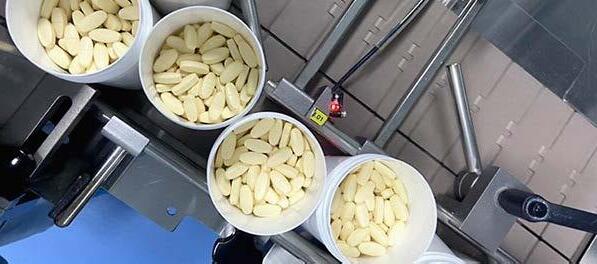
The packaging industry has a crucial role to play in mitigating climate change. That is why we are engaged in decarbonisation efforts and initiatives on a broad scale. This means taking action to minimise carbon emissions from our own operations and products, and from our value chain. As part of our standard business practices, all sites are committed to continuously reducing energy consumption and implementing sitespecific efficiency initiatives.
In March 2025, Pact Group made a decisive commitment to the SBTi – a globally recognised standard for aligning corporate emissions reduction strategies with climate science.
To meet the SBTi’s rigorous criteria we have expanded our existing near-term Scope 1 and 2 emissions reduction targets, originally focused on Australia and New Zealand, to cover our entire global operations.
In addition, we have also developed and committed to new Scope 3 emissions targets, covering indirect emissions across our value chain. Lifecycle tools were used to inform our emissions reduction roadmap and planning, in particular for our purchased goods.
These targets are now embedded in both our near-term and net-zero commitments, reflecting the critical role that supply chain and customer-related emissions play in our overall climate impact.
In August 2025, our targets were officially validated by the SBTi, becoming one of 100 companies in Australia to have done so.
This achievement reflects our commitment to long-term value creation and operational resilience as we globally transition to a low-carbon economy. For our customers in particular, it provides confidence that we are managing climate-related risks and opportunities in line with global best practice and reinforces our role as a trusted partner focused on building a more sustainable future.
We will continue to report transparently on our progress and work collaboratively across our value chain to deliver on these targets.
Reduce Scope 1 & 2 GHG emissions by

Reduce Scope 1 & 2 GHG emissions to
by end 2030 (from a FY21 base year) by 2050 (from a FY21 base year)
Reduce Scope 3 GHG emissions by
Reduce Scope 3
by end 2030 (from a FY24 base year) by 2050 (from a FY24 base year)
Scope 3
other indirect GHG emissions that result from activities not owned or controlled by the organisation, but the organisation indirectly affects in its value chain.
Globally, we report our greenhouse gas (GHG) emissions and energy in accordance with the World Resources Institute Greenhouse Gas Protocol and specifically in Australia we report our greenhouse gas emissions and energy use through the National Greenhouse and Energy Reporting Scheme. All our emissions globally are externally reviewed and assured to ensure the accuracy and completeness of data.
The breakdown of this result is as follows:
• Australian emission and energy content factors were derived from the National Greenhouse and Energy Reporting (Measurement) Determination 2008, compilation no. 18 - compilation date 31 August 2024.
• New Zealand emission and energy content factors were derived from the Ministry for the Environment - Measuring Emissions Guide 2025, Emissions Factors Workbook 2025.
• Emissions factors for the rest of the world were obtained from the Carbon Database Initiative.
Scope 1 & 2 emissions: 50% reduction by end 2030 from a FY21 base year. Net zero carbon emissions by 2050.
With our Emissions Reduction Targets (ERT ) being updated to cover the Group globally, our FY21 base year has had a significant recalculation. This recalculation also incorporates organisational changes that occurred in FY25.
Comparing our FY25 emissions with the adjusted FY21 base year, we have achieved an 11.2% reduction in emissions across Pact Group. The reported reduction is lower than in FY24 due to the expansion of the ERT to the entire Group, not because of an increase in emissions from our Australian and New Zealand businesses.
Pact Group anticipates that it will not require the use of carbon offsets to meet our Scope 1 and 2 emissions reduction target.
Operational optimisation
Energy efficiency & renewable electricity
Ongoing activities related to equipment upgrades, energy efficiency, waste, water and other aspects of operations that will contribute to emissions reductions across all three scopes.
Continuous energy-saving initiatives and investments in both self-generated and purchased renewable electricity will achieve emissions reductions across all Pact sites.
Raw material recycled content
Supplier Engagement
Maximising the use of recycled resin and steel in the packaging we manufacture will significantly reduce emissions.
Pact’s supplier engagement program will reduce emissions by focusing on acquiring goods and services with lower emissions intensity.
In March 2025, Schneider Electric conducted a Type 2 Energy Efficiency Audit at one of our Contract Manufacturing facilities. The audit involved engineers inspecting each individual piece of equipment used within the facility and used electrical dataloggers to help identify where electricity was being used the most. The audit revealed significant opportunities to reduce energy consumption and carbon emissions.
The audit’s findings provide a replicable framework for energy and emissions reduction across Pact’s broader manufacturing portfolio. One key transferable strategy includes conducting detailed inspections of compressed air systems, specifically via air leak detection and compressor pressure audits, and integrating variable speed drives into compressors where feasible.
Pact Group will be conducting a trial of this activity in early FY26 for our largest facilities in Australia and, if successful, will look to roll the work out further.

In late FY25 the team in our Truganina facility completed an upgrade of its 10 litre General Line Can (GLC) line, replacing much of the equipment downstream of the welder. The new equipment includes a new induction heater, which will reduce both electricity and natural gas usage by an estimated 5%. This is the first part of a larger project of machinery upgrades within the GLC manufacturing section of the site.
Over the course of FY25, Pact’s total on roof photovoltaic (PV) portfolio generated in excess of 4,100,00 kWh of electricity, an increase of 2,283,958 kWh, or 124%, compared to FY24.
The increase is largely attributed to a substantial 1.8 MW (1,800 kW) on-roof PV system located on our Pact Retail Solutions hanger manufacturing and sorting facilities in Bangladesh. The system is nearly three times as large as Pact’s now second largest system.
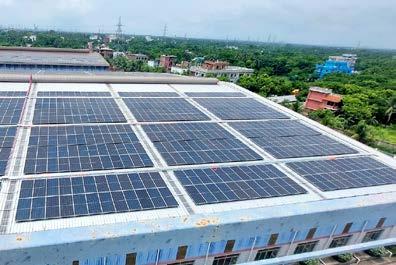
The solar generated electricity in FY25 is the equivalent of avoiding approximately 2,600 tonnes2 of CO2e emitted through the consumption of electricity from the grid. We continue to look for opportunities with our landlords/building owners to deliver more on-roof solar on our facilities. Of the total solar electricity generated, Pact sites consumed 3,815,506 kWh with the rest exported to the grid.
This means approximately 0.9% of Pact’s total energy consumption came from renewable sources in FY25.
While reducing our Scope 1 and 2 emissions is essential, the emissions generated across our value chain (Scope 3) are significantly higher.
In FY24, a number of reporting improvements allowed the Group to calculate our Scope 3 emissions with far greater accuracy than previously reported, to the point where we were able to set future targets using FY24 as the base year. This FY24 base year was slightly adjusted to account for structural changes and identified refinements through our validation work with SBTi.
*Each category has been calculated following the methodologies in the Greenhouse Gas Protocol –Corporate Value Chain (Scope 3) Standard
For further details of the methods used please refer to Notes and Assumptions (page 97).
We use a mix of primary and secondary data for Scope 3 calculations, with data coming from internal stakeholders and suppliers.
In FY25, Pact’s total Scope 3 emissions, in relation to the above categories was 1,025,090 tCO2e. Similar to most other companies involved in manufacturing, Pact’s largest source of Scope 3 emission is the raw materials we use to produce our products.
For FY25 we are reporting an increase in Scope 3 emissions by +7.6% compared to FY24. This increase is primarily due to more comprehensive reporting of emissions within our value chain, which has not been fully replicated within our FY24 base year calculation. This will be rectified in future reporting as we continue to improve the quality of our calculation methodology.
Reducing Pact’s emissions by using recycled resins
The results of our internal lifecycle assessment using the PIQET3 show that the use of externally produced recycled resin reduces the Scope 3 emissions of purchased resins by approximately 44% for rPET, 45% for rHDPE, 40% for rPP and 45% for rLDPE per unit of weight purchased, when compared to the equivalent virgin resin.
The use of recycled resin purchased from Circular Plastics Australia also reduces our upstream transportation emissions as the recycled resin is produced locally as opposed to being imported from overseas.
Reduction of Scope 3 emissions – purchased goods and services (recycled resins vs virgin resin).
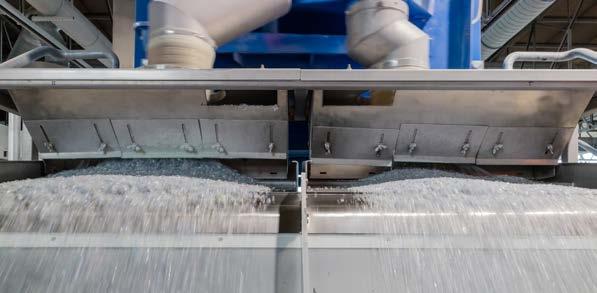
As a leader of the circular economy, Pact aims to achieve sustainability in all facets of our operations, including our supply chain which has a network of more than 6,000 suppliers.
Pact continued to evaluate our sustainable procurement practices in FY25, with a foundation laid for significant progress in FY26.
In FY25, Pact went out to market for an application that could help us better assess the ESG credentials and risks of our supply chain, in particular our suppliers.
Pact chose Exiger in late FY25, with the implementation to be completed in the first half of FY26. Exiger will allow us to engage more easily with our large supply chain on Scope 3 emissions, in particular the carbon footprint of our purchased goods and services, and to understand if our suppliers also have targets to reduce their own emissions. This information will allow us to add carbon as a key consideration when making purchasing decisions in future, as required to meet our own Scope 3 targets.
In FY25 we also prepared a new Responsible Sourcing Policy and commenced updating our Supplier Code of Conduct. The updated Supplier Code of Conduct will be communicated to suppliers in FY26.
A subset of Pact Group facilities carry out activities such as metal surface coating, drum reconditioning and plastics recycling, which can emit atmospheric pollutants including particulate matter, nitrogen oxides, sulfur dioxide and volatile organic compounds.
To minimise emissions, these facilities are equipped with emission control technologies in line with Pact’s Environmental Policy, which also stipulates the requirement of regular monitoring. Examples of these technologies include thermal oxidisers, baghouses, and wet and dry air scrubbing systems.
Under Australian environmental legislation, eight Pact sites are required to submit annual reports to the National Pollutant Inventory.
In FY25, these Pact sites emitted an estimated 49.1 tonnes of air pollutants in total.
From 1 January 2025, new legislation in Australia requires businesses to report on their climate-related financial risks and opportunities in line with the Australian Sustainability Reporting Standards. These mandatory disclosures are designed to improve transparency and help customers, investors and communities better understand how companies are managing the impacts of climate change.
Pact Group is classified a Group 1 organisation, which require disclosures to be reported for FY26. To ensure we meet these new requirements with integrity and clarity, we have engaged an experienced sustainability consultant to support our compliance journey.
This proactive approach reflects our commitment to transparency, accountability and supporting our customers in a low-carbon future. We believe that clear, science-aligned reporting is essential to build trust and drive meaningful climate action.
Reducing waste and water usage across our operations is vital to lowering our environmental impact, improving efficiency and supporting the Group’s Impact 2030 Targets. Initiatives such as closed-loop water systems and centralised waste tracking help conserve resources, reduce costs and ensure compliance with local regulations.
In FY25 all Pact Group sites, including Pact operated joint ventures, conducted an internal self-assessment on waste management. The assessment showed that only approximately 60% of our facilities had separate waste receptacles available to properly sort the waste streams they generate, in particular for waste streams with small volumes. This shows that although Pact has been doing a great job of segregating most waste, there is still room for improvement.
To complement internal and third-party waste assessments conducted, in FY26 Pact will partner with Cleanaway to perform waste deep dives at three key facilities. These deep dives involve actively sorting through bulk general waste bins to identify opportunities to further divert from landfill, opportunities that will likely also apply to our global operations.
Below is Pact’s worldwide waste generation breakdown for FY25.4
Pact has a global commitment to sending zero recyclable plastic waste to landfill. All plastic waste generated on our sites in Australia and New Zealand is sent back (where practical) to our internal recycling facilities, where it is reprocessed into recycled resin and then used to manufacture new products.
In FY25, Pact-operated recycling sites received more than 6,030 tonnes of material from our manufacturing sites and Circular Plastics Australia.

As this was a newly established Impact 2030 Target in FY25, progress against this target will be reported in the FY26 Sustainability Report.
In our Packaging division, water is primarily used to cool plastic after moulding. These sites are designed to minimise water loss through closed-loop recirculation systems, which connect moulding machines to cooling towers or chillers. These systems cool and return water for reuse, significantly reducing consumption.
Our Recycling division uses more water due to the intensive cleaning required for post-consumer plastic sourced from household collections and container deposit schemes. Water is reused multiple times in the washing process until it becomes too contaminated to be effective, at which point it is treated by on-site water treatment equipment, before ultimately being discharged to sewer.
Water use has continued to increase as our recycling operations increase in capacity. In FY25, Pact’s Recycling sites in Australia and New Zealand consumed approximately 109,500 kL of mains water, a 7.4% increase compared to FY24.
In FY25, Pact set the Pact Recycling division an internal target to begin to identify opportunities to reduce water usage.
In FY25, Pact’s Recycling sites in Australia and New Zealand consumed approximately
109,500 kL of mains water.

As this was a newly established Impact 2030 Target in FY25, progress against this target will be reported in the FY26 Sustainability Report.
Pact facilities that use water in production have formal agreements with local water authorities to manage trade waste, which is treated wastewater discharged into municipal sewer systems. This wastewater must meet strict quality standards, including pH, temperature, biological oxygen demand and suspended solids.
Several Pact sites operate on-site water treatment systems that recycle water back into production, reducing both freshwater use and wastewater discharge. We are committed to improving the efficiency of these systems and are working with industry experts to adopt advanced treatment technologies.
In FY25, Pact Group processed and discharged approximately 250,000 kL of treated wastewater into municipal sewer systems in Australia.
The CPA (PET) facility in NSW is currently undertaking a project to develop and trial advanced water treatment technologies that will greatly reduce the amount of suspended solids in the wastewater that is discharged to sewer. If successful, the technology, which uses membranes as a means of filtration, will be the first of its kind to be deployed in a PET recycling facility and will be a critical milestone in exploring the future reuse of all water used on site as part of a closed loop system.
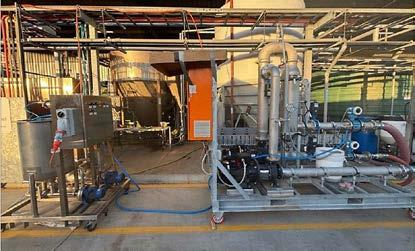
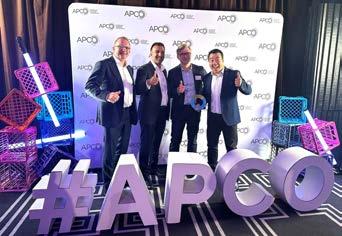
Pact operated CPA (PET) won the 2024 APCO Award for Improved Recycling System for our two PET plastic recycling facilities that can each recycle up to 1 billion PET beverage bottles a year. The recycled bottles are used to make new bottles and food packaging, creating a circular economy for plastic in Australia.


Providing a safe, respectful, and values-led workplace for highly motivated and engaged talent.




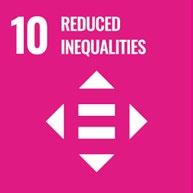

+ 100% of sites to have completed a critical health and safety risk self-assessment annually
Health & Safety Engagement & Development
Diversity & Inclusion
+ 100% of high risk exposures identified assigned actions annually
+ 100% SIF/PSIF investigated and closed annually
+ Pay equity by gender at each level of the organisation by 2030
+ 30% direct reports to the ELT (excluding administration) to be female by 2030
+ Employee engagement score above manufacturing industry benchmark (assessed biennially)
2030 Target
Safety is Pact’s most important value. The organisation is committed to maintaining a safe and inclusive workplace where every individual can perform at their best each day. This commitment is reflected in proactive risk management, open communication and continuous improvement across all sites and teams.
100% of sites to have completed a critical health and safety risk self-assessment annually
FY25 Progress self-assessment. of our sites completed a critical health and safety risk In FY25, 89%
2030 Target
100% of high risk exposures identified assigned actions annually
FY25 Progress of identified high-risk exposures were assigned actions. In FY25, 96%
2030 Target
100% SIF/PSIF investigated and closed annually
FY25 Progress of SIF/PSIF were investigated and closed. In FY25, 93%
The One Pact Workplace Health, Safety, and Environment (WHSE) Council continues to diligently shift the business towards proactively managing risk exposure and implementing critical risk controls. This ongoing work spans our strategic priorities across four key categories: risk management, incident management, systems and governance. By focusing on these areas, we continue to ensure that our WHSE Framework remains robust and effective. This work is fundamental to our WHSE Framework, enabling the business to execute on the WHSE Policy intent with precision and confidence.
FY25 reporting focused on key safety performance indicators, including total recordable injury close-out rates, hazard identification and resolution, SIF and PSIF events, as well as safety-related behavioural observations.
*6,177 hazards identified
Health and safety risk assessments and inspections occur continuously across all our sites and are tracked in VelocityEHS, a safety management system. Elements of plant and equipment are covered in Group health and safety audits; however, these audits are system-specific and generic. Site-specific equipment safety inspections or audits are conducted as needed, in accordance with Pact’s Health and Safety Management System. In FY25, more than 220 risk assessments/inspections were conducted specifically in relation to plant and equipment.
A key part of our WHSE Priorities and Actions is the control of critical risk. In order to effectively focus on risk reduction activities, the previous Pact Group Minimum Standards were meticulously reviewed, resulting in the reclassification of various elements. These elements have been categorised into three distinct risk levels:

Eight additional elements were elevated to critical or significant, and a dedicated webinar was held to guide sites through the changes, self-assessment process and expectations. A user guide was also introduced to support consistent risk mitigation across all categories. Site-specific action plans, based on these assessments, were reviewed and endorsed by divisional leadership — reinforcing accountability and our commitment to high WHSE standards. Critical Risk Significant Risk WHSE Compliance

Pact’s WHSE Transformation is centred on embedding safety into every aspect of work, shifting from a reactive model to a proactive, risk-based approach. This evolution was accelerated through a two-day “Supercharge Xcelerate our Potential” conference, where WHSE leaders from Australia, New Zealand and Asia collaborated with an external safety expert to explore global shifts in safety culture. The focus was on building a learning-oriented environment that prioritises managing risk exposure over incident response — supporting Pact’s broader business transformation and commitment to continuous improvement.

As part of our commitment to a safe and healthy workplace, Pact has introduced manual handling mentoring sessions to educate employees on best practices and reduce injury risks. These sessions promote safe techniques and support a proactive approach to managing manual handling hazards.

To strengthen manual handling safety, Pact has introduced a shared resource hub with guidelines, risk assessments, and a practical assessment tool that helps employees identify and manage risks before injuries occur. A dedicated webinar on hazardous manual handling explored key topics such as body stress and ageing impacts, and introduced a traffic light system to prioritise risks. By promoting continuous education and sharing learnings across sites, Pact fosters a proactive and collaborative approach to manual handling safety.
Pact’s Psychological Fitness Program, led by the Care Safe team, is being piloted across multiple sites to strengthen psychological safety through training, surveys and tailored action plans. A core focus is early intervention, with 775 discomfort reports resolved — 31% from labour hire team members. Confidential reporting via QR codes and secure injury management through SolvInjury facilitates privacy and equitable care. The program also includes onsite physiotherapy, wellbeing days and targeted interventions. Complementing these efforts, Pact distributes wellbeing packs covering topics like psychological health, connection, gratitude and hearing care, and offers free flu vaccinations to all employees in Australia and New Zealand.

Pact is committed to supporting the physical, social and psychological health of our employees and working towards removing the stigma attached to mental illness. Our EAP is available for employees and their families in Australia and New Zealand. This service offers access to confidential and independent counselling to provide emotional, mental and general psychological support. It is intended to enhance the wellbeing of our people when they need it and to provide support which may not otherwise be available or accessible.
& Inclusion
At Pact, we believe diverse perspectives and an inclusive culture drives innovation, strengthens our ability to attract top talent, and delivers exceptional outcomes. In FY25, we advanced our Diversity & Inclusion goals by focusing on gender balance in leadership, reducing pay disparity, and embedding equity into recruitment and performance processes.
FY25 Progress
In FY25, Pact’s pay disparity for salaried roles in Australia and New Zealand (excluding CEO and ELT positions) reduced from as of 30 June 2025.5 to
In FY25, we achieved female representation in Senior Leadership Team (SLT).
In FY26, Pact has committed to introduce a new Remuneration Policy to ensure that employees are compensated fairly and competitively, free of unconscious bias based on gender, ethnicity, disability, age or other aspect of demography. By having a clear policy on how employees are remunerated for their role, this can lead to better attraction and retention of talent, reduction of all costs associated with turnover, and foster a sense of value and recognition among employees, which can boost morale and productivity.
Pact’s Diversity Policy will be updated in FY26 to include clear processes for employee consultation to promote an inclusive workplace where all employees feel valued and respected. An inclusive environment where diversity is celebrated can lead to higher levels of employee engagement and satisfaction. Team diversity brings varied perspectives and ideas, fostering innovation and creative problem-solving. Diverse teams also better reflect the communities we operate in, and allow us to better understand and cater to a diverse customer, consumer or employee base, enhancing the company’s market reach and competitiveness.
Implementing a Flexibility Policy in FY26 will provide clarity on how Pact can support employees to balance their professional and personal lives more effectively. Flexible work arrangements can lead to higher productivity as employees can work within their capacity to be most productive and in environments that suit them best. Flexibility can reduce stress and burnout, leading to lower absenteeism and improved overall health and wellbeing of employees. By offering flexible work options, Pact can attract and retain a wider range of candidates, including those who may have caregiving responsibilities or other commitments.
5,230 employees
Below is the breakdown of our employees in FY25. The above data does not include our Chair and Non-Executive Directors. Board composition information can be found in Pact's FY25 Annual Report
62 19
43Other employees 5,157 1,768 3,387 2 Total 5,230 1,789 3,439 2
In FY25, 31% of our workforce was female.
We believe in recognising the contributions that drive our business success, so we offer our employees a range of benefits and entitlements.
• An opportunity to be part of a purpose-led and values-driven, sustainable organisation that leads the circular economy.
• Kudos Recognition Program — employees can earn reward points for living the Group’s Values redeemable on a range of items, and make charitable donations.
• Health insurance discounts (New Zealand only).
• 18 weeks paid parental leave for primary carers and two weeks for secondary carers (Australia only).
• EAP — a free, confidential and independent counselling service (NZ and AU only).
• MyLearning — programs to boost employee development, including leadership courses and online learning modules.
• Career opportunities across a global organisation.
• An opportunity to be part of a purpose-led and values-driven, sustainable organisation that leads the circular economy.
• Flexible working including different roster and shift availability.
• EAP — a free, confidential and independent counselling service (NZ and AU only).
• MyLearning — programs to boost employee development, including leadership courses and online learning modules.
• Traineeships — fully-funded Certificate III in Process Manufacturing.
• Career opportunities across a global organisation.
Waged employees refer to employees paid hourly under an award or enterprise agreement. Salaried employees refer to employees paid a fixed annual amount.
Pact does not employ anyone under the age of 18 at any of our sites globally. Pact’s pre-employment checks ensure that all employees meet our minimum age requirement of being at least 18 years old prior to commencing employment.
Labor relations are a cornerstone of our commitment to social responsibility. Our waged employees are compensated in line with applicable wage legislation. In many cases, we go beyond these requirements, with many employees benefiting from industrial agreements.
In FY25, Pact maintained 43 active industrial agreements across Australia, New Zealand and Nepal. These agreements covered more than 1,700 employees — representing approximately 33% of the global workforce.
Pact upholds the rights of employees to freedom of association and collective bargaining, recognising these as vital to empowering our workforce. Our employee arrangements reflect the varied nature of our workforce. All of Pact’s sites have formal employee representatives, consultation committees or union structures that encourage two-way communication on topics such as wages, health and safety, working conditions, and training.
Our contractual labour agreements comply with statutory requirements for termination and redundancy processes and, in many instances, exceed these regulatory standards.
Diversity and inclusion are key areas of focus at Pact, with a commitment to building a workplace where everyone feels safe, respected and empowered to thrive.
Pact has a dedicated Diversity and Inclusion Committee made up of team members from across the business to help guide inclusive decision-making and ensure that diverse voices are heard and represented.
Key initiatives include strategies to attract diverse talent, improve gender balance, deliver inclusion training, enhance accessibility and safety through policy reviews, and leverage multilingual technology to support broader engagement. Through open dialogue and a commitment to reflecting the communities we serve, Pact continues to embed inclusion into everyday operations and drive innovation through diverse perspectives.

On International Women’s Day in 2025, our sites came together for a special virtual event to discuss the urgent need to “Accelerate Action” on gender equality, and to celebrate the achievements and contributions of women across our operations.
Hundreds of people from across Pact’s global operations joined a special virtual event on International Women’s Day 2025 to hear from Wendy Stops, a highly accomplished leader with over 30 years’ experience at the intersection of technology and business. Wendy shared her insights, personal experiences, and vision for accelerating action toward a more equitable future. Her leadership extends beyond the corporate sphere — she has served on the Board of Fitted for Work for over nine years, including two years as Chair.
At Pact, we recognise that employee engagement and development are deeply interconnected and essential to our success. By offering meaningful learning opportunities, clear career pathways and purpose-driven work, Pact fosters a culture where people feel valued and motivated. Supportive leadership, open communication and a positive work environment help employees see how their contributions connect to broader organisational goals.
In FY25, we achieved an engagement score of ; 3% higher than the Asia-Pacific (APAC) manufacturing sector average of 73%.*
* Source: Culture Amp, Manufacturing APAC, January 2025 Benchmark.

The award recognises the Group’s commitment to workplace learning and development in partnership with Competenz. This partnership focuses on developing tailored training programs that address skills gaps and foster career development within the company.
Pact Packaging New Zealand significantly expanded its vocational training program in FY25, doubling employee participation from 32 to 63 across ten sites. The initiative offers training up to Level 4 in Manufacturing, creating clear pathways for unskilled workers to become apprentices and advance their careers. This strengthens both workforce capability and long-term retention.
Creating, achieving and sustaining employee engagement begins with actively listening to our people. By systematically gathering and analysing employee feedback, we gain valuable insights that inform the design and delivery of programs and initiatives across the Group. These efforts are instrumental in fostering a more inclusive, responsive and high-performing workplace environment.
Established in 2020, the Pact Pulse Employee Engagement Survey provides a structured approach to understanding what matters most to our team members. Through this initiative, we gain deeper insights into employee engagement, identify areas for improvement, and celebrate the strengths that define our workplace culture. The feedback gathered continues to shape our people-focused programs and supports our commitment to building a more inclusive and responsive organisation
Participation rates help us understand how representative the feedback is. Participation
Engagement is a measure of people’s connection and commitment to the Group and its Vision and Values.
HOW WE COMPARED BASED ON: 91% 76% +6 +5 +16 +3 Responses: 4,526 PARTICIPATION SCORE
PREVIOUS Pact Pulse Engagement Survey 2023
BENCHMARK Manufacturing APAC, January 2025*
* Source: Culture Amp, Manufacturing APAC, January 2025 Benchmark.


As a values-led organisation, we embed our core Values into every aspect of our culture. These commitments have shaped a set of behavioural statements that guide how we work together. Demonstrating our Values is a key part of
The Values we live by everyday:




At Pact, we’re dedicated to helping every employee reach their full potential. We offer a wide range of learning and development opportunities designed to enhance skills and support career progression. By investing in our people, we empower them to achieve their personal and professional goals while ensuring Pact continues to lead through innovation and excellence.
All salaried employees have access to our online learning management system, Learn Upon, which hosts over 360 courses across diverse topics including wellbeing, health and safety, interpersonal skills, leadership, technical knowledge, and regulatory training. Of these, more than 220 courses are available for selfenrolment, allowing employees to upskill at their own pace.
In FY25, salaried employees based in Australia and New Zealand completed mandatory training in some or all of the below programs as applicable to their role:
• Anti-bribery and corruption
• Code of Conduct and business ethics
• Competition and consumer protection
• Equal employment opportunity, inclusion and discrimination, and workplace bullying and harassment
• Health, safety and sustainability induction
• Modern slavery awareness and prevention training.
Our waged employees also had access to various types of training in FY25. Given the nature of their roles, training for these employees was either held onsite by senior leaders or online in group sessions. WHSE webinars were regularly held for site managers and WHSE representatives to upskill them in relevant areas such as machine safety and manual handling. Depending on the varying requirements and risks on site, other formal training for all site employees included topics such as first aid, chemical handling, diversity and inclusion, lock-out tag-out and electrical safety, firefighting and emergency preparedness, forklift safety, environmental management and biodiversity conservation.
In addition to the above, Pact also delivers tailored and specialised training programs to meet specific development needs across the business. For example, tailored training was delivered to the New Zealand senior leadership team focused on sustainable packaging. The session aimed to build their understanding of the key factors that influence packaging recyclability, such as colour, size, plastic type, as well as the guidelines and targets set by APCO. It also covered how Pact leverages tools like the PREP tool to assess recyclability, and the connection between packaging recyclability and its emissions footprint. It was an engaging and interactive session that successfully upskilled our leadership team.
Similar training was provided to the Pact Contract Manufacturing division, focusing on what makes packaging recyclable, and aligned with best practice recyclability principles and APCO sustainable packaging guidelines. This highly interactive session explored in detail the types of packaging Pact places on the market through our own brands and identified practical changes we can implement to enhance circularity.
In line with our strong focus on ESG, the ESG Steering Committee initiated a collaborative training session between the Pact Supply Chain and Sustainability teams. The session explored the impact of procured goods on Pact’s emissions profile and our broader emissions reduction goals. Given that the Supply Chain team centrally manages the purchase of a significant portion of Pact’s goods and services, they play a key role in influencing our Scope 3 emissions. While the session was technical and detailed, it successfully brought both teams together with a shared environmental commitment to reducing emissions across the business.
In FY25, Pact achieved food-grade compliance for our rFresh-100 resin - a recycled HDPE resin produced at our Circular Plastics Australia (PE) Laverton site. To support this milestone, an online training session was delivered to employees across sales, finance and packaging, with participants joining from across Australia and New Zealand. The session provided a comprehensive overview of what food-safety compliance for resin involves, the technical process behind achieving this certification, and the potential packaging conversion opportunities enabled by the inclusion of rFresh-100 in food-grade applications.
Pact provides ongoing IT training for all salaried employees with a strong emphasis on security awareness. This training is delivered through various formats, including targeted learning modules and phishing simulation exercises. Security Awareness Training is structured into two streams: a company-wide program that reaches all employees, and a tailored program designed for specific groups based on factors such as department, user risk profile and updates to company policy.
At Pact, we are committed to fostering a high-performance culture where every team member understands how their contributions drive our collective success. Our Performance Framework aligns individual goals with Pact’s Values and strategic priorities, ensuring a clear connection between personal achievement and organisational impact.
We believe in the power of a growth mindset, encouraging all team members to take ownership of their development and continuously build their skills. Leaders are empowered to support this journey, cultivating a culture of learning, feedback and improvement.
Working towards a high-performance culture, all Pact employees are accountable to deliver on the expectations of their role in line with our Values, reinforcing our commitment to fairness, accountability and continuous improvement.
Our Performance Framework is underpinned by five key organisational pillars:
Financial Performance
Operational Excellence
People & Engagement
Strategic Imperatives
We have developed a suite of resources to support both employees and managers through the Performance at Pact process, making it easier to set meaningful goals, track progress and celebrate achievements.
Pact’s performance management processes vary between waged and salaried employees, but all employees participate.
Waged employees are continuously reviewed against how they are living Pact’s Values and performing against the requirements of roles as specified in their respective industrial agreements.
For salaried employees, we run a continuous performance review cycle set out below.
End-of-Year Performance Review Annual Salary Review
Mid-Year Check-In
Every employee creates an individual performance and goal plan aligned to business strategy and needs. Employees also create a personal development and career plan tailored to their learning and career aspirations. This ensures that growth is purposeful and progress is measurable.
Our mid-year check-in provides an opportunity to reflect on progress and recalibrate objectives if necessary, helping to keep performance, contribution and development on track.
End-of-year performance review
The end-of-year performance review stage celebrates achievements and informs our annual salary review process, ensuring recognition and reward are aligned with performance.
Our structured cycle is complemented by regular assessment of individual performance and ongoing conversations about growth and development throughout the year.
At Pact, recognition is more than just a reward, it is a reflection of how we live our Values every day. Pact’s Kudos Program provides a platform for salaried employees to recognise their colleagues for actions that embody Pact’s Values and contribute to our Vision. Whether demonstrating leadership, collaboration, innovation, or care for others, every Kudos moment reinforces the behaviours that shape our culture.
Each recognition is accompanied by Kudos points, which can be boosted by peers and redeemed through the Kudos store, creating a tangible link between valuesdriven behaviour and reward.
This program complements our Performance Framework by:
• Reinforcing positive behaviours aligned with our Values ;
• Encouraging peer-to-peer recognition across all levels;
• Celebrating everyday excellence in real time.
By integrating recognition into our culture, we ensure that living our Values is not only expected but also celebrated.
Waged employees are recognised and rewarded for their efforts at a site level.





In FY25 more than 5,660




Kudos recognitions were sent. Each recognition is aligned with one of the Group’s Values.









The Succeeding at Pact Guide was developed to support Pact Group’s strategic transformation as the business advances toward its Impact 2030 Targets. Originating from discussions at the SLT conference, the guide helps employees understand and embody Pact’s refreshed Mission and Purpose. It outlines the Company’s strategy for growth, defines core values, and provides a framework for performance and accountability — helping equip every team member to contribute to Pact’s success

The Succeeding at Pact Guide serves multiple purposes:
• It outlines Pact’s strategy for growth, including our Vision to lead the circular economy.
• It defines core Values such as safety, customer focus, integrity, innovation and collaboration, and explains how these values translate into everyday behaviours.
• It provides a framework for performance and accountability, encouraging employees to plan effectively, perform at their best, embrace change, and execute with excellence.
To launch the guide, two versions were created — a long version for salaried employees and a short version for waged employees — along with site posters to support visibility and engagement. The guide has also been integrated into a training module to ensure consistent understanding and application across the organisation.
Pact’s internal talent acquisition team drives a consistent and effective hiring process that supports our high-performance culture. By managing recruitment centrally, we ensure every hire aligns with our values and our Vision to lead the circular economy. This in-house approach allows us to attract and retain top talent while building capability across the business.

In FY25, Pact hired more than 1,300 new employees and the Group’s employee turnover rate was approximately 12%.
This year, Pact’s internal Talent Team continued to focus on early careers and internal career progression.
Early careers
In FY25 Pact supported 11 apprentices across our sites in a range of engineering, mechanical and technical fields. These apprenticeships are part of a long-term strategy to develop the next generation of industry leaders.
Internal careers
At Pact, we are committed to supporting the growth and development of our people. To maximise internal career progression, all salaried vacancies are advertised internally, helping to raise awareness of opportunities across our diverse Group and encourage career mobility.
We also provide dedicated tools to support internal candidates, helping employees navigate the recruitment process, update their CVs and prepare for interviews with confidence.
In FY25, 39 employees formally progressed into new roles through internal transfers or promotions. While this figure reflects recorded movements, we acknowledge that some organic mobility may not be captured in our systems – meaning the true number is likely higher.
In FY25, Pact Packaging Temuka’s Kate Cooper was named a finalist for the prestigious AMA NZ Manufacturing Apprentice of the Year award, recognising her outstanding performance, leadership and growth throughout her three-year apprenticeship.
Kate, a key operator at our Temuka steel drum plant is a standout talent in the Pact team. This recognition highlights her mechanical aptitude, commitment to continuous improvement and ability to lead by example on the factory floor.
Her journey through the Apprenticeship Program has been marked by rapid development in technical skills, hands-on problem-solving, and a deep understanding of continuous improvement principles. Kate’s drive and humility have made her a role model for others in the business.



Conducting our business responsibly and investing in programs that positively impact the communities in which we operate.



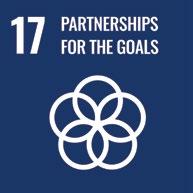
+ 1st quartile ESG performance as 3rd party assessed by 2030
Transparency
Supply Chain
Community
+ 80% of Pact’s key suppliers to have completed an ESG assessment by 2026
+ Reduce Scope 3 emissions by 10%, from a FY24 base year, by 2030 through sustainable procurement and supplier engagement
+ 100% of our Community Giving Budget allocated to support high-impact charities that align with our Vision, reflect our Values, and benefit the communities we operate in
In FY25, we introduced our ambitious Impact 2030 Targets to accelerate progress across ESG pillars and deliver meaningful outcomes for our people, communities and the planet.
To enhance ESG performance across the Group, Pact established the ESG Steering Committee in FY25. Chaired by our CEO and led by a cross-functional executive team, the ESG Steering Committee is focused on embedding ESG into our core operations, while building capability in systems, data, processes and people, to support our sustainability ambitions, including our goal of achieving a top quartile ESG score by 2030.
Environment
• Carbon emissions
• Energy use/source
• Resource depletion
• Water
• Waste
• Pollution
• Product end of life
• Biodiversity
• Certification
• Product stewardship
Social
• Working conditions
• Career management
• Diversity, inclusion, equity
• Community focus
• Social dialogue
• Safe & healthy workplace
• Anti-discrimination
• ESG training
• Customer health & safety
Governance
• Anti-corruption
• Modern slavery & human rights
• Ethical sourcing & sustainable procurement
• Diversity & inclusion
• Risk management
• Conflict of interest
• Information security
Chair: CEO Committee Members
• Chief Financial Officer
• Executive General Manager People & Culture, Sales, Marketing & Innovation
• Executive General Manager Supply Chain
• General Counsel & Company Secretary
• Circular Economy Advisor
• Group Environment & Sustainability Manager
• Sustainable Packaging Manager
Since its formation, the ESG Steering Committee has taken decisive steps to strengthen our governance and performance, including:
• Overseeing the development of Impact 2030 Targets.
• Setting validated net zero targets through the SBTi.
• Updating and expanding key policies to strengthen human rights and environmental due diligence in the supply chain.
• Implementing a new ESG platform to enhance supplier controls and assurance.
• Delivering ESG training for suppliers and internal teams.
• Embedding ESG targets into senior leadership KPIs from FY26.
In FY25, Pact’s 3rd party assessed ESG score was
rd quartile)
Transparency is central to our ESG journey. Pact selected EcoVadis as our core ESG scoring platform in FY25. While our current EcoVadis score (3rd quartile) does not yet reflect our full ambition, it has been a catalyst for change and a core focus for the ESG Steering Committee.
The ESG Steering Committee has developed targeted actions and improvement plans across EcoVadis’ four main assessment categories: environment, labour and human rights, ethics, and sustainable procurement.
We are committed to continuous improvement and aim to exceed the 60-point threshold — placing Pact in the upper quartiles of rated companies—through genuine, measurable impact across all four ESG categories.
Pact’s ESG performance is independently assessed by other third-party platforms, reinforcing our commitment to accountability and progress.
In FY25, Pact Group earned a Carbon Disclosure Project (CDP) score of C for Climate Change, the same as in FY24. In an effort to increase our CDP score, we have undertaken the following in the last 12 months:
• Updated the coverage of our Scope 1 and 2 targets, to include our global operations.
• Committed to a Scope 3 reduction target.
• Achieved SBTi target validation of our near-term and Net Zero targets.
• Undertaking a climate change risk assessment, to be completed late 2025.
Several Pact sites are members of Sedex, which enables sharing of ethical supply chain data and improvement in our supply chain activities with customers. Sedex is a not-for-profit membership organisation dedicated to driving improvements in ethical and responsible business practices in global supply chains.
We received a ‘Committed’ badge in FY25. While our current EcoVadis score does not yet reflect our full ambition, it has been a catalyst for change and a core focus for the ESG Steering Committee.

As a signatory to the UNGC and a member of the local chapter, Global Compact Network Australia, Pact Group upholds the principles of universal human rights, including accessibility, non-discrimination and labour rights across our operations. Our annual UNGC Communication on Progress can be downloaded from the UNGC website.
By embedding ESG principles into procurement practices, Pact reinforces its commitment to sustainable sourcing, strengthens transparency and accountability across its supply chain, and drives measurable progress toward its Impact 2030 Targets.
Target
80% of Pact’s key suppliers to have completed an ESG assessment by 2026
FY25 Progress
This Impact 2030 Target aligns with Pact’s commitment to sustainable procurement and responsible sourcing, which are key focus areas for the ESG Steering Committee. We are currently exploring the most effective and meaningful approach to implementing this initiative. Progress against this target will be reported in the FY26 Sustainability Report
2030 Target
Reduce Scope 3 emissions by 10%, from a FY24 base year, by 2030 through sustainable procurement and supplier engagement
FY25 Progress
As this was a newly established Impact 2030 Target in FY25 progress against this target will be reported in the FY26 Sustainability Report.
In FY25, Pact continued to strengthen its Supplier Onboarding Program, applying a rigorous screening process to all new suppliers. This system evaluates suppliers against key social and environmental criteria, reinforcing Pact’s commitment to partnering only with those who align with our Values and expectations.
As part of this process, suppliers are required to adhere to our Supplier Code of Conduct, Modern Slavery Policy, Whistleblower Policy, and Anti-Bribery and Corruption Policy. These policies set out the environmental, labour and human rights standards we expect from our suppliers. We also seek to include binding contractual obligations which reflect these policies in every supplier contract.
In FY25, 99% of all new suppliers managed by Pact’s head office procurement function were screened using our onboarding systems and accepted all requirements stipulated in our policies.
Pact’s Integrity and Ethical Sourcing Committee continued to meet quarterly to discuss and review various supply chain topics and issues, including sustainable procurement. Sustainable procurement is also a key focus of Pact Group’s ESG Steering Committee.
Pact is committed to embedding sustainability across every facet of our operations-including our expansive supply chain of more than
6,000
suppliers.
In FY25, we continued to evaluate and strengthen our sustainable procurement practices. A key milestone in this journey was the implementation of a platform that provides end-to-end visibility across our supply chain, enabling us to proactively identify and manage potential risks. We will continue rolling out this system in FY26 to further enhance transparency and accountability.
Pact manufactures products from both tinplate and steel, which can contain conflict minerals. Conflict minerals are tantalum, tin, tungsten and gold that were extracted and directly or indirectly benefit armed groups in the Democratic Republic of Congo.
Pact procured steel from two suppliers and tinplate from one supplier in FY25. Pact does not knowingly obtain or supply products that contain conflict minerals. Pact requests Conflict Minerals Reporting Templates from our steel and tinplate suppliers to verify country of origin of our raw material metals.
As a global company operating in 15 countries, we are dedicated to fostering positive connections among our employees, customers and the communities in which we operate. Through our Community Giving Program, we actively support initiatives and activities that make a meaningful impact.
100% of our Community Giving Budget allocated to support high-impact charities that align with our Vision, reflect our Values and benefit the communities we operate in.
In FY25, Pact proudly allocated 100% of its Community Giving Budget to support impactful charities, including Fitted for Work, Movember, and the World Wildlife Fund’s Challenge 60. These partnerships reflect our commitment to empowering women, advancing men’s health, and protecting the environment — causes that align with our Values and drive meaningful change in the communities we serve.

Movember is a global movement raising awareness and funds for men’s mental health, suicide prevention, prostate cancer and testicular cancer. During FY25, Pact employees supported the campaign by growing moustaches, hosting events and staying active.

Fitted for Work is a charity that empowers women, non-binary and gender-diverse job-seekers to achieve economic independence through meaningful employment. Their job-readiness services equip clients with practical skills, knowledge and confidence to thrive in the workplace. With a strong focus on inclusion, Fitted for Work provides a safe and welcoming environment for individuals of all backgrounds, abilities and identities. By offering both in-person and online support nationally, they ensure accessibility for all. Pact is proud to support an organisation that believes employment is a pathway to purpose, connection and lifelong empowerment.

In March 2025, Pact proudly joined the World Wildlife Fund’s Challenge 60, the world’s largest environmental movement. This global initiative encourages individuals and organisations to reconnect with nature through 60 minutes of outdoor activity per day to promote environmental awareness, health, and wellbeing.
By participating, Pact reinforced its commitment to empower employees to engage with the natural world and champion the values of environmental stewardship at every level.
In March 2025, Pact proudly joined the world’s largest environmental movement, championed by the World Wildlife Fund (WWF), to reconnect people with nature and promote health and wellbeing.
Across the company, approximately 60 Pact employees embraced the challenge to spend 60 minutes outdoors each day, soaking in the beauty of the natural world while raising funds to help regenerate it. From beach walks to bush hikes, our team showed up with energy and purpose.
This inspiring global initiative culminated in Earth Hour on 31 March, when millions around the world switched off their lights to show the power of collective action for the planet.




On April 24, a fire destroyed the Abilities Group recycling plant in Glenfield, Auckland.
Pact New Zealand joined the countless individuals and companies helping Abilities Group get back on its feet, donating 100 bins from our Sulo business in East Tamaki.
Abilities Group is a community recycling charity dedicated not just to sustainability, but to creating meaningful employment, training and support for over 100 people with disabilities. The organisation’s work transforms both lives and waste, fostering opportunity, purpose and a circular economy.
The team provides comprehensive recycling services for a wide range of materials, such as electronic waste, documents, batteries, cardboard and polystyrene across the Auckland region. By keeping these materials out of landfill, Abilities Group is helping to create a cleaner, greener Aotearoa for all Kiwis.

Pact Group is a signatory to a number of external organisations and agreements committed to sustainability.
• APCO
• ACOR
• Chemistry Australia
• New Zealand Plastic Packaging Product Stewardship Scheme
• Society of Plastics Engineers, Australia and New Zealand
• Plastics New Zealand
• WasteMINZ, New Zealand
• New Zealand Food and Grocery Council
• Advanced Manufacturing Aotearoa
• United Kingdom (UK) Plastics Pact
• US Plastics Pact
• Standards Supplier Ethical Data Exchange (SEDEX)
• UNGC
• ACOR
• Chemistry Australia
• Plastics New Zealand
Pact Group has representatives on several external government and industry working groups. These groups are committed to reducing environmental and end of life impacts from packaging.
Government
• Circular Economy Ministerial Advisory Group
• Collective Action Group
• Technical Advisory Committee
• Rigid Plastics Material Stewardship Committee
Chemistry Australia
• Plastics Council
• Plastics Industry Leadership Group
• Kerbside Industry Leadership Group
• Recycle Right Industry Leadership Group
• Regulation Industry Group member
• Container Deposit Scheme Industry Group
Other
• Department of Climate Change, Energy, Environment and Water industry consultation on packaging regulation
• Recycling Victoria’s Resource, Recovery, Recycling and Waste Industry Group
• Recycling Working Group for the Container Return Scheme, New Zealand
• Priority Product Status Working Group, Agrecovery, New Zealand
• Advancing Manufacturing Aotearoa
• Waikato Chamber of Commerce
• New Zealand Ice Cream Association
• Blueberries New Zealand
The UNGC is the world’s largest voluntary corporate sustainability initiative, where businesses commit to aligning their operations and strategies with ten universally accepted principles in the areas of human rights, labour, environment and anticorruption, and to progress the SDG.
As a signatory to the UNGC and a member of the local chapter, Global Compact Network Australia, Pact Group strives to uphold the principles of universal human rights, including accessibility, non-discrimination and labour rights across our operations.
We demonstrate our UNGC commitment to human rights and labour matters through the Group’s:
• Code of Conduct, which requires all Pact employees and representatives to behave fairly, ethically and in accordance with all laws;
• Equal Opportunity, Harassment and Bullying Policy, which outlines Pact’s commitment to being an equal opportunity employer and ensuring our workplace is free of unlawful discrimination, harassment and bullying;
• Modern Slavery Policy, which prohibits Pact employees and representatives from engaging in any activity that would constitute modern slavery or could result in modern slavery practices, and sets minimum standards for Pact’s supply chain on modern slavery and labour-related matters;
• Supplier Code of Conduct, which requires that our suppliers adhere to the same high standards we hold ourselves to; and
• Supplier Screening Process (more on page 82), which ensures we conduct due diligence across our supply chain to support the elimination of all forms of child, forced or compulsory labour, and other forms of modern slavery.
We lodged our annual UNGC Communication on Progress in June 2025 which can be downloaded from the UNGC website.
Modern slavery describes situations where coercion, threats, or deception are used to exploit victims and undermine their freedom. Examples include: trafficking in persons; slavery; servitude; forced labour; forced marriage; debt bondage; child labour; and deceptive recruiting for labour or services. Modern slavery is unlawful.
As a signatory to the UNGC, we are committed to supporting the abolition of child labour and forced labour worldwide. Pact is committed to taking decisive action in the event that it identifies modern slavery in its operations or supply chain and has established an Integrity and Ethical Sourcing Committee to ensure that modern slavery risks are identified, evaluated and addressed appropriately.
Pact released its Modern Slavery Statement for the year ended 30 June 2024 in December 2024 in accordance with the reporting requirements under the Modern Slavery Act 2018 (Cth) and the Modern Slavery Act 2015 (UK). A copy of Pact’s Modern Slavery Statement is available on the Pact website: Click here
As part of this reporting, all (100%) of Pact’s sites (‘controlled entities’) were assessed for human rights impact or risks, predominantly based on country of operation.
Including both the assessments conducted for the Modern Slavery Statement and reports to the whistleblower hotline (as part of Pact’s Whistleblower Policy), no child labour incidents were reported in relation to our operational sites in FY25.
Pact Group has a zero-tolerance approach to modern slavery and has adopted a Modern Slavery Policy that sets our commitment to:
• responsibly source goods or services to use in our business;
• ensure there is transparency in our approach to tackling modern slavery in our own business and throughout our supply chains;
• take action to prevent, mitigate and, where appropriate, remediate the harm caused by modern slavery occurring in our business and supply chains;
• comply with any applicable laws and regulations throughout the world; and
• establish open effective communication channels for the reporting of actual or suspected instances or risks of modern slavery occurring in our operations and supply chains.
The Modern Slavery Policy is reviewed periodically and was last reviewed in February 2025.
In FY25 Pact employees completed various training programs on modern slavery awareness and prevention.
Our Group Code of Conduct outlines our expectations in respect of our sense of corporate responsibility and integrity.
Our Code of Conduct (Code) outlines how the Group expects its employees and representatives to behave and conduct business in the workplace. It provides a benchmark for professional behaviour to support the Group’s business reputation and corporate image within the community. It covers key topics including: conflict of interest; anti-bribery and corruption; gifts and commissions; facilitation payments; political contributions; and securities trading.
All Group employees, Directors, officers, authorised representatives, contractors, consultants and agents must comply with the Code. We have also established a Supplier Code of Conduct (Supplier Code) which sets out the Group’s expectations of its suppliers of goods and services, contractors, consultants and trading and business partners. The Code and Supplier Code encourages the reporting of unethical behaviour and breaches of policy or Company Values. We are committed to ensuring that those who do so are not disadvantaged or discriminated against when making reports in good faith and this commitment is supported by our Whistleblower Policy.
The Code is supported by a range of Board and Group policies designed to ensure compliance with laws and regulations. The Code and policies are reviewed as needed to reflect changes to legislation, regulations or business risks. Training for employees is provided either in person or via our online learning management system. Further information regarding the Code and Group policies is available via our website: Click here.
On occasion, the Group receives notices from relevant authorities pursuant to local environmental legislation and in relation to the Group’s environmental licences and consents. The Group takes all notices seriously, conducting a thorough investigation into the underlying causes and ensures it takes every opportunity to continuously improve systems. Pact works with the appropriate authorities to address requirements and proactively manage obligations.
In FY25 all notices received were resolved within the timeframe specified, and the Group has taken practical precautions to prevent the re-occurrence of the relevant events.

In FY25, Pact received no convictions for breach of environmental laws
Through its policies and other governance infrastructure, the Group establishes a Compliance Management Framework to enable Pact to manage its internal and external obligations and compliance risks effectively and efficiently. Pact’s Policy Oversight Committee meets regularly to ensure the Group’s policies and their outcomes support Pact’s Mission, Values and strategic goals, and keep pace with applicable regulatory and legislative changes. This section provides a sample of certain key Pact policies and the Group’s approach to various governance matters.
Our Anti-Bribery and Corruption Policy (ABC Policy) outlines the standard of appropriate behaviours and business conduct in respect to Anti-Bribery and Corruption (ABC) matters. Training on the policy and applicable laws is provided to relevant employees. The ABC Policy provides that all material breaches of the policy will be reported to the Board immediately. We continue to focus on developing and enhancing tools and procedures to identify and mitigate ABC risks.
In FY25, Pact engaged KPMG to conduct an antibribery and corruption risk assessment to evaluate the effectiveness of Pact’s ABC Framework and control procedures in managing bribery and corruption-related risks across specified jurisdictions which management identified as high-risk. The assessment examined the adequacy of existing ABC controls and provided recommendations to strengthen the framework. This included a proposed methodology to enable Pact Group to test controls and update the risk assessment on an ongoing basis.
Our Competition and Consumer Act Compliance Policy outlines Pact’s commitment to ensuring its representatives understand and act in accordance with their obligations under competition and consumer laws (CCL) in all countries in which Pact Group operates. The policy is underpinned by a Protocol for Dealings with Competitors and Competition Law Golden Rules that provide practical guidance to employees to facilitate compliance with competition law obligations. Pact places great importance on compliance with this key area as it impacts how we deal with our competitors, suppliers and customers.
A breach of CCL can result in significant penalties (to the Company and individuals) and significant damage to the Company’s goodwill and reputation in the marketplace.
Adherence to this policy is a condition of employment at, or engagement with, Pact Group. The Company encourages the reporting of any conduct that may breach CCL.
Our Environmental Policy sets out our commitment to continuously improve the environmental performance of our operations and services. This policy reinforces our commitment to become the number one partner of sustainable choices for our customers.
We are committed to being an equal opportunity employer and will not tolerate unlawful discrimination, harassment, bullying, vilification or victimisation in the workplace.
Our Equal Opportunity, Harassment and Bullying Policy sets out our expectations for high standards of behaviour in the workplace and the procedures for making complaints and investigating issues relating to unlawful discrimination, harassment or bullying.
The Company recognises that people are its most important asset and is committed to the maintenance and promotion of workplace diversity to ensure a discrimination-free place of work. Encouraging diversity and inclusion drives the Company’s ability to attract, retain and develop the best talent. It also enables an engaged workforce, the delivery of the highest quality services to our customers and the continued growth of the business.
The Company’s Vision for diversity incorporates a number of different factors, including gender, ethnicity, disability, age and educational experience.
Pact is committed to setting and achieving robust measurable diversity and inclusion objectives.
Active management of salary reviews with a “lens on gender” has helped Pact identify and take steps to reduce pay equity imbalance. The Group lodged its annual public report with respect to the applicable reporting period with the Workplace Gender Equality Agency including detail on gender pay equity.
The Group is committed to ensuring all work is completed incident and injury free, in line with our Pact Safe strategic ambition. Our Workplace Health and Safety Policy provides an overview of the Company’s commitment to workplace health and safety, and what is expected of employees and others.
Protecting the privacy of our stakeholders is important to us. The Privacy Policy explains how we collect and manage personal information.
Our Quality Policy outlines our commitment to operate our business in a manner that meets customer and international quality standards.
Conducting our business ethically and with integrity includes looking at our supply chain. Our suppliers must meet specified minimum standards and conduct business in an ethical and professional manner at all times. The Supplier Code of Conduct is aligned with other Group policies including the Modern Slavery Policy and includes reference to: ethical standards; labour and human rights; health and safety; environmental management; application and monitoring; and reporting concerns and breaches.
Pact’s Whistleblower Policy supports the Group’s Code of Conduct and is designed to promote and reinforce our culture of honest and ethical behaviour. The purpose of this policy is to encourage employees to raise concerns about misconduct, malpractice, irregularities or any other behaviour which is dishonest, corrupt, illegal or inconsistent with any of the Group’s Values. It also sets out how the Group intends to make sure a whistleblower is protected for reporting unacceptable activities. We have also established an externally facilitated hotline to enable employees and other stakeholders to report any concerns.
In FY25, ten reports were made under the Whistleblower Policy. All reports were investigated and appropriate actions were taken based on the outcomes of the investigations.
Tax Transparency
Our approach to tax is governed by the following key principles:
• Pact pays tax where the underlying economic activity occurs.
• Pact does not hide assets or income through secrecy provisions.
• Pact does not shift profits to low or zero-tax jurisdictions.
These principles are enforced through a Tax Risk Governance Policy ensuring Board review and approval of significant tax decisions, and a Tax Risk Management Framework that guides management in the day-to-day administration of tax matters.
Political Contributions and Activities
Our Code of Conduct prohibits the use of corporate funds for political purposes. Pact does not contribute any monies to any candidate for election to a political party.
We do not prohibit political activity undertaken by an employee in their own individual, private capacity. However, to eliminate any appearance of coercion in such political activities, it is prohibited for any supervisor to solicit funds from a subordinate for political purposes.
Pact supports the involvement of its employees in community activities and professional organisations. However, outside activity must not create a conflict (or the appearance of a conflict) of interest.
Conflicts of interest, whether actual or apparent, must be avoided and disclosed. Examples of conflicts of interest include (but are not limited to) the giving or receiving of gifts, financial interests or personal relationships. Directors and employees are required to declare conflicts of interest. Pact’s process relating to conflicts of interest is outlined in a number of Group policies including our Code of Conduct, Board Charter and Policy for Dealing in Securities (including in relation to inside information).
The Board is conscious of related party dealings between the Group and interests associated with the Company’s Chair, Mr Geminder. A Related Party Protocol is in place to monitor and govern these transactions and to ensure compliance with the Corporations Act 2001
Controls adopted by Pact to manage conflicts of interest may include:
• ensuring a transaction is conducted at arm’s length;
• removal of conflicted Directors, employees or teams from a transaction or decision; and
• avoiding a transaction.
We are committed to maintaining a Register of Related Party Transactions and Register of Notification of Interests to facilitate effective management and reporting..
The Company’s Continuous Disclosure Policy is designed to ensure the timely release of material price sensitive information to investors as well as ensuring that stakeholders are kept informed of major developments affecting Pact and its business.
The Company is also committed to establishing and maintaining processes that ensure the integrity of its corporate reporting.
Data security is fundamental to protect the privacy of information and to protect critical intellectual property. Pact has operational safeguards in place to detect and prevent cyber attacks, such as employee training, monitoring of our networks and systems, ensuring strong data protection standards, and maintaining and upgrading security systems. We have adopted Group-wide cyber security incident response policies, plans and procedures that align with the ISO 27001 Framework, mock data breach assessments, cyber security training and penetration testing. To date, we have not experienced any significant impacts.
Pact is committed to strong corporate governance, maintaining a framework that aligns with the Company’s Values, meets stakeholder expectations and supports the Group’s strategic objectives.
In the year ended 30 June 2025, the Board adopted a corporate governance framework comprising principles and policies that were broadly consistent with the ASX Corporate Governance Council’s Corporate Governance Principles and Recommendations (4th edition) (ASX Recommendations).
To assist stakeholders in accessing key documents outlining our approach to corporate governance, we maintain a Corporate Governance section on our website.
We seek to continuously update the Group’s Governance Framework through: periodic review of Board and Group charters, codes and policies; independent reviews such as audits of the Company’s Risk Management Framework; and listening to stakeholder feedback on Pact’s performance and reporting.
Pact’s annual Global Site Audit Program (GSAP), delivered in partnership with KPMG, enhances risk awareness, identifies systemic issues and drives continuous improvement. Developed with internal stakeholders, GSAP assesses minimum control standards for key financial areas (including those related to fraud risk) and adherence to critical internal policies and procedures.
Audits are conducted on a rotational basis, tailored to each site’s risk profile, and integrated with Pact’s internal audit function. Findings and resulting actions are reported to the Audit, Business Risk and Compliance Committee (ABRCC) and the Board.
As part of our Risk Engineering Program, sites also undergo audits to assess a broad range of risks and support proactive mitigation.
Across these programs, 34 audits were completed.
In conjunction with audits, Pact uses a dedicated platform to track compliance obligations across Australia and New Zealand. This data feeds into our compliance dashboard, enabling assessment by theme (eg. ABC, competition and consumer, privacy and data protection). Compliance obligations in other countries are managed by a site-based compliance team.
The ABRCC receives updates on risk, management and compliance on a regular basis.

The Board of Directors is responsible for the overall corporate governance of Pact Group. The Board’s role is to ensure that the Group is properly managed, to protect and enhance shareholders’ interests, and to ensure the Group operates in an appropriate environment of control and corporate governance.
During FY25 the Board comprised of an Executive Chair (Non-Executive Chair until 22 October 2024), one Executive Director (Managing Director & Group CEO), two independent Non-Executive Directors, and two Non-Executive Directors (appointed 25 September 2024).
The Board is supported by the ELT which is responsible for day-to-day operations and management of the Group. Tenure of Pact’s Directors range from one to 15 years. Board members have extensive experience in a range of relevant industries, including manufacturing, finance, information technology operations and public company experience. Additional details on the Group’s Board members, are provided in our Annual Report and on our website.
In FY25, the Board delegated specific responsibilities to two standing governance committees: the Nomination and Remuneration Committee and the Audit, Business Risk and Compliance Committee. The Board has also appointed a Disclosure Committee with responsibility for compliance with Pact’s continuous disclosure obligations. Further information regarding the Disclosure Committee is included in our Continuous Disclosure Policy
The Company has established the functions reserved for the Board and these are contained in the Board Charter and the Group’s Delegated Authority Policy. The CEO and senior executives, who are accountable to the Board, are responsible for matters that are not specifically reserved to the Board, primarily being the day-to-day operations and management of the Group.
The Group’s policies typically provide guidance to employees and other relevant stakeholders on the reporting of an actual or suspected policy breach or concern. Material breaches and concerns are reported to applicable Board Committees and to the Board.
Pact Group’s FY25 Sustainability Report has been prepared in accordance with GRI Standards.
GRI Index
GRI 2: General Disclosures
2-3
2-6 Activities, value chain and other business relationships 3-10
2-7 Employees
2-9
2-11 Chair of the highest governance body
2-12 Role of the highest governance body in overseeing the management of impacts 2, 79, 93-94
2-13 Delegation of responsibility for managing impacts 2, 79, 93-94
2-14 Role of the highest governance body in sustainability reporting 2, 79, 93-94
2-15
2-22
GRI 303: Water and Effluents 2018
303-1
303-2
GRI 306: Waste 2020
306-2
306-3
306-4
306-5
GRI 308: Supplier Environmental Assessment 2016
GRI 401: Employment 2016
GRI
GRI 409: Forced or Compulsory Labor 2016
GRI
Operations and suppliers at significant risk for incidents of forced or compulsory labour 82, 89
1 Waste diversion tonnage is calculated using actual product average weights.
2 Calculated using the National Greenhouse and Energy Reporting (Measurement) Determination 2008, in each of the regions the on-roof solar system is located.
3 Based on an initial PIQET life cycle assessment, where only the material used was changed and all other data points remained the same. Specific reductions will vary for each case.
4 Waste generated excludes our Pact Retail Solutions division due to low accuracy of data.
5 Pay parity measures how an employee’s salary compares to the median of the salary range for their role’s grade—providing insight into how consistently we pay for roles of similar size and scope. This analysis covers all Pact-paid salaried employees (permanent and fixed-term) based in Australia and New Zealand, excluding the Group’s Chair.
6 Location and Market Based as defined in GHG Protocol Scope 2 Guidance, section 6.2.
The calculation methodology (or reasoning for exclusion) of each Scope 3 categories is listed below:
Category 1
Purchased Goods and Services: Calculated using a combination of the supplier-specific method where available, and average-data method. Procured Chemicals (excluding resins and plastics) was the only material calculated using the spend-based method. Services are excluded due to low materiality (<1% of total).
Category 2
Capital Goods: Calculated using the spendbased method.
Category 3
Fuel-and-Energy-Related Activities: Calculated using the average data method.
Category 4
Upstream Transport and Distribution: Calculated using a combination of distancebased method and average-data method, where distance-based data was not available.
Category 5
Waste Generated in Operations: Calculated using the average-data method.
Category 6
Business Travel: Calculated using the distance-based method.
Category 7
Employee Commuting: Calculated using the average-data method.
Category 8
Upstream Leased Assets: Many of Pact’s facilities and forklifts are leased. The emissions from these leased assets are included in our Scope 1 and 2 emissions as we use the operational control consolidation approach.
Category 9
Downstream Transportation and Distribution: Calculated using a combination of distancebased method and average-data method where distance-based data was not available.
Category 10
Processing of Sold Products: Calculated using the average-data method, for recycled resins manufactured and sold to external customers and filling of manufactured packaging.
Category 11
Use of Sold Products: There are no direct-use phase emissions associated with the products produced by Pact Group (packaging, recycled plastic material, chemicals used for personal or homecare). Any indirect-use phase emissions are not included (such as the use of hot water when using shampoo).
Category 12
End of Life Treatment of Sold Products: Calculated using the average-data method.
Category 13
Downstream Leased Assets: Pact Group do not have any downstream leased assets.
Category 14
Franchises: Pact Group do not have any franchises.
Category 15
Investments: Pact’s 50% share of the Viscount Reuse Joint Venture.

We were engaged by Pact Group Holdings Ltd (Pact) to undertake a limited assurance over the total Scope 1 and 2 greenhouse gas (GHG) emissions included in its 2025 Sustainability Report
Based on the work performed, nothing has come to our attention that caused us to believe that the total Scope 1 and 2 GHG emissions presented in Pact’s 2025 Sustainability Report (the Subject Matter) has not been prepared and presented fairly, in all material respects, in accordance with the Greenhouse Gas Protocol Corporate Standard (the Criteria)
For the year ended 30 June 2025, we reviewed the total Scope 1 and total Scope 2 greenhouse gas emissions, expressed in tonnes of carbon dioxide equivalent (t.CO2-e), for Pact as presented in Pact’s 2025 Sustainability Report
Tota l Scope 1 GHG emissions: 17,355 t CO2-e Total Scope 2 GH G emissions (location-based): 228,884 t CO2-e
Tota l Scope 2 GHG emissions (market-based): 251,951 t CO2-e
Criteria applied by Pact
In preparing the total Scope 1 and total Scope 2 GHG emissions Pact applied the GHG Protocol Corporate Standard
Our responsibility and independence
Our responsibility was to express a limited assurance conclusion on the fair presentation of Pact’s Scope 1 and Scope 2 GHG emissions presented in its 2025 Sustainability Report.
We have maintained our independence and confirm that we have met the independence requirements of the APES 110 Code of Ethics for Processional Accountants and have the required competencies and experience to conduct this assurance engagement.
P Pact’s responsibility
Pact’s management was responsible for selecting the criteria and preparing and fairly presenting the total Scope 1 and Scope 2 GHG emissions in accordance with the Criteria. This responsibility included establishing and maintaining internal controls, adequate records and making estimates that are reasonable in the circumstances.
O Our approach to the review
We conducted this review in accordance with Australia Standard on Sustainability Assurance ASSA 5000 General Requirements for Sustainability Assurance Engagements, and where applicable Australian
Standard for Assurance Engagements on Greenhouse Gas Statements (ASAE 3410) and the terms of reference for this engagement as agreed with Pact. The evidence obtained is sufficient and appropriate to provide the basis for our limited assurance conclusion.
Our review procedures included:
Conducting interviews with Pact personnel to understand the business and its reporting processes and systems for collecting, storing, and collating data
Making inquiries with Pact’s Management to assess the risk of misstatement due to fraud
Undertaking analytical review procedures to assess the reasonableness of data used to calculate the total Scope 1 and Scope 2 GHG emissions
On a sample basis, conducting tests of detail of underlying data to assess the accuracy of the data, including tracing data used to estimate emissions amounts to their points of origin
Checking the appropriateness of calculation methodologies and conversion factors used to calculate emissions amounts and testing the accuracy of calculations
Assessing the reasonableness of any estimates used in the calculation of the total Scope 1 and Scope 2 GHG emissions
Confirming the total Scope 1 and Scope 2 GHG emissions stated in the 2025 Sustainability Report

Foresight Consulting Group Pty Ltd
Joshua Martin, Director
15/09/2025